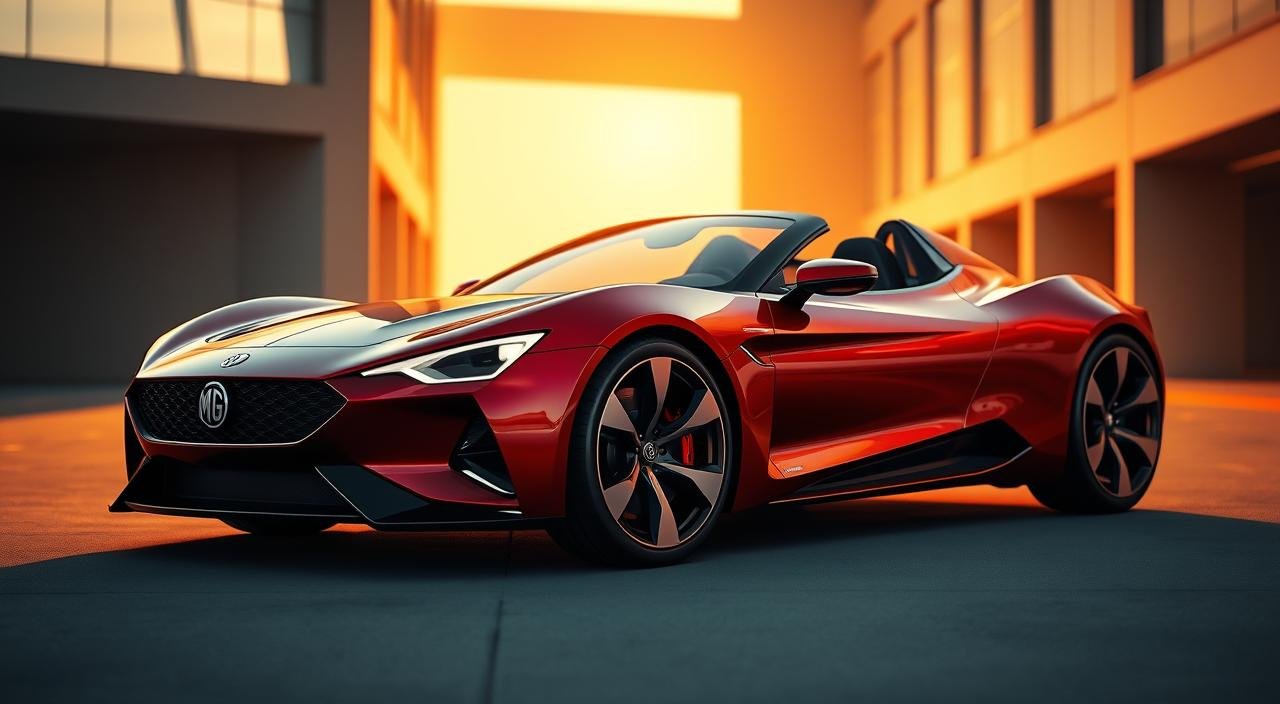
Aug
Can an electric car give the thrill of a sports car and cost less than many luxury sedans? The MG Cyberster, India’s first all-electric convertible roadster, is a game-changer. It starts at ₹74.99 lakh, entering the premium electric vehicle market with a bold move.
This two-seat electric car offers stunning performance and the latest tech. It’s fast and furious, challenging what we think about electric cars in India. With 510 horsepower and 725 Newton-meters of torque, it goes from 0 to 100 kilometers per hour in just 3.2 seconds.
Those who reserved their Cyberster early get a ₹2.5 lakh discount. This brings the price down from ₹74.99 lakh. It has a 77kWh battery pack for a 580-kilometer range on a single charge. MG will sell it through its Select showrooms across India.
The Cyberster takes a unique spot in India’s market. Luxury cars make up just over 1% of sales but are growing fast. This electric roadster could change how people see premium electric vehicles in the country.
Key Takeaways
- MG Cyberster launched at ₹74.99 lakh as India’s first all-electric convertible
- Early reservation holders receive a ₹2.5 lakh discount on purchase price
- Dual motors produce 510hp and 725Nm torque for 0-100kph in 3.2 seconds
- 77kWh battery provides 580km MIDC-rated range on single charge
- Available exclusively through MG Select showrooms across India
- Targets luxury car segment growing at 3.3% annually in India
Overview of the MG Cyberster
The MG Cyberster is a game-changer in India’s electric vehicle market. It’s the country’s first and only convertible EV. With a price of ₹74.99 lakh, it’s the most affordable convertible in India.
What Makes the Cyberster Stand Out?
The Cyberster offers a unique mix of open-air fun and zero-emission power. It has a dual-motor setup that gives 510 horsepower and 725 Nm of torque. This makes it fast and exciting, all for a great price.
The soft-top opens in just 10 seconds. This lets drivers easily switch between coupe and convertible modes.
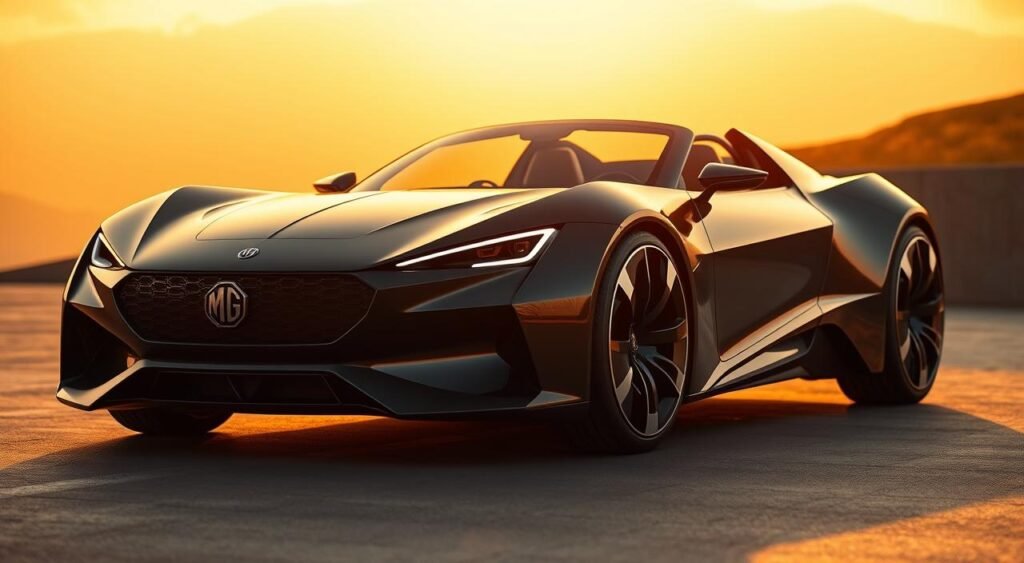
Key Specifications and Features
| Specification | Details |
|---|---|
| Power Output | 510 HP |
| Torque | 725 Nm |
| Top Speed | 200 km/h |
| Drivetrain | Dual-motor AWD |
| Drag Coefficient | 0.269 Cd |
Design and Aesthetics
The Cyberster’s design is a blend of futuristic styling and classic roadster looks. It has scissor doors for a dramatic entrance and exit. The 20-inch alloy wheels add to its sporty look.
The car’s aerodynamic shape has a drag coefficient of 0.269 Cd. This helps with both speed and efficiency. The Cyberster is a bold statement in car design, showing off tech and performance in the premium segment.
Performance Capabilities
The MG Cyberster is a game-changer in the electric car world. It’s a fast sports car that goes from 0-100 kph in just 3.2 seconds. It also has a top speed of 200 kph, making it a top choice for thrill-seekers.
Its dual-motor setup makes it a high performance machine. It challenges what we think of as traditional sports cars.
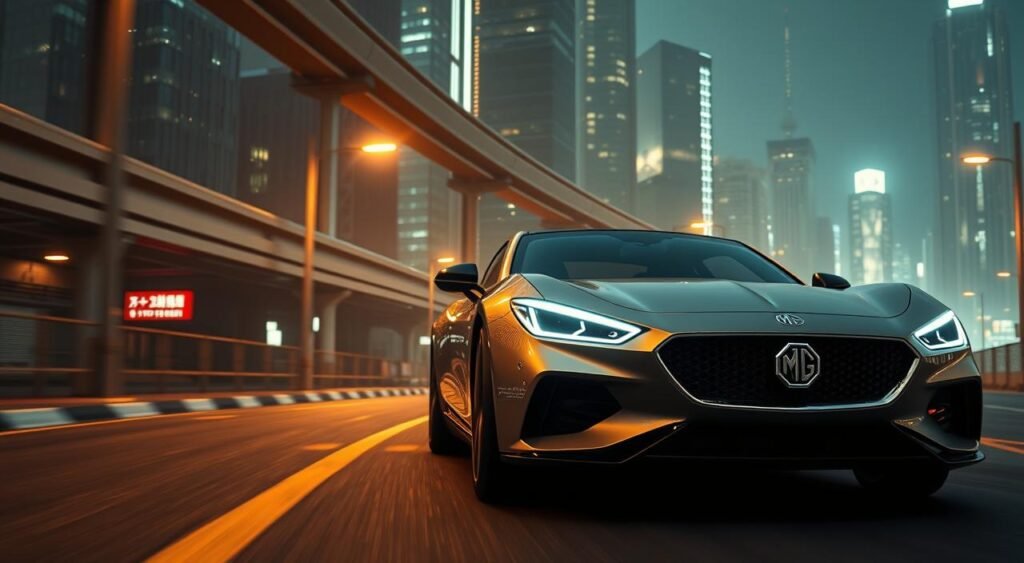
Acceleration and Top Speed
The Cyberster is incredibly fast, beating many rivals. It goes from 0-100 kph in just 3.2 seconds. Its top speed of 200 kph is unmatched by many cars, including the BMW Z4 M40i.
Electric motors give drivers a thrilling experience. Every time you press the accelerator, you feel a strong push-back.
Battery Life and Range
The Cyberster’s 77 kWh battery pack means you don’t have to worry about running out of power. It has a range of 580 kilometers, perfect for long trips. This range is unmatched by many high performance cars, making it both fast and practical.
Electric Motor Power Output
The Cyberster has two electric motors that together produce 510 horsepower and 725 Nm of torque. Its all-wheel-drive system ensures great traction in all conditions. This setup gives better control than rear-wheel-drive sports cars, even in tough weather.
Technological Innovations
The MG Cyberster latest model is a big step forward in electric vehicle tech. It combines the latest tech with a focus on the driver, setting new standards for electric roadsters. From its futuristic cockpit to its advanced connectivity, every detail is designed to improve your drive.
Cutting-Edge Infotainment System
The Cyberster’s interior has a cool trio of curved displays for an immersive digital space. A 7-inch touchscreen on the center console is easy to use, even on the move. It supports wireless Android Auto and Apple CarPlay, making phone integration easy.
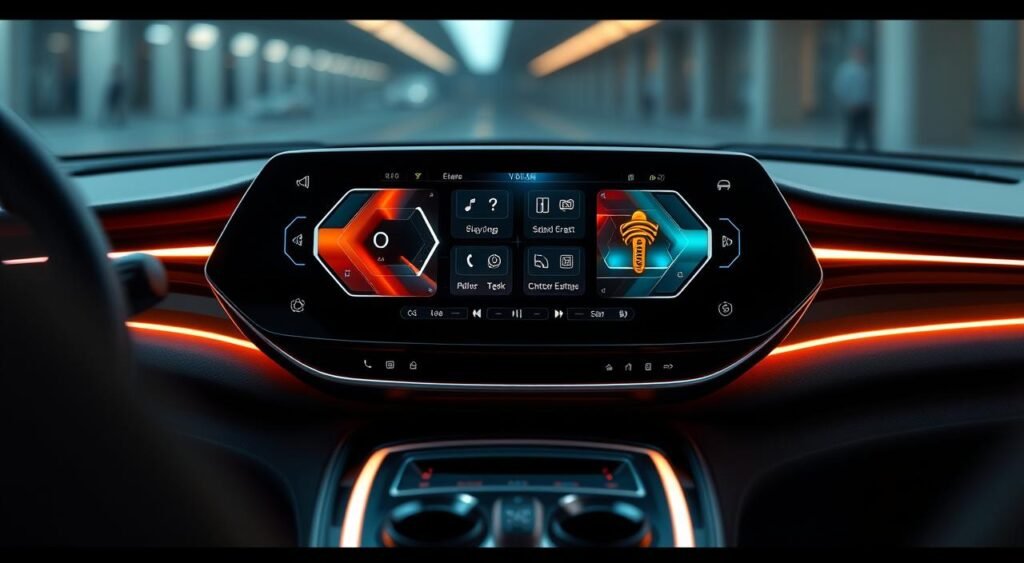
The premium Bose audio system makes every drive sound like a concert. These features together create an entertainment center that matches the car’s speed and power.
Advanced Safety Features
Safety is key with Level 2 ADAS technology in the Cyberster. It has many systems to prevent accidents and keep you safe:
- Adaptive cruise control with stop-and-go functionality
- Lane keeping assistance and departure warning
- Automatic emergency braking with pedestrian detection
- Blind spot monitoring with rear cross-traffic alert
- 360-degree camera system for better visibility
Connectivity Options
The Cyberster’s modern connectivity makes owning it a better experience. It offers digital integration that keeps you connected without taking your eyes off the road. Real-time navigation updates, remote monitoring, and software updates keep your car up-to-date.
| Connectivity Feature | Function | Benefit |
|---|---|---|
| 5G Network Support | High-speed data connection | Instant updates and streaming |
| MG iSMART App | Remote vehicle control | Pre-conditioning and monitoring |
| Voice Assistant | Hands-free operation | Safer driving experience |
| Multiple USB-C Ports | Device charging | Keep devices powered |
The Cyberster also shows MG’s commitment to green design. It has vegan leather upholstery, showing that luxury and sustainability can go hand in hand.
Pricing and Availability
The MG Cyberster launched at ₹74.99 lakh is a big deal in India’s electric sports car world. It’s priced to be appealing, making it a great choice for those who want speed without spending too much. Those who reserved early get a ₹2.5 lakh discount, making it even more appealing.
Launch Price in India
The Cyberster’s launch price of ₹74.99 lakh is a great deal in the premium sports car market. It shows MG’s dedication to bringing top-notch electric tech to India. The early bird discount brings the price down to ₹72.49 lakh for those who reserved early, adding to the value.
Comparison with Competitors
When we look at the Cyberster’s price, it’s clear how it stacks up against its rivals:
| Model | Price Range | Powertrain |
|---|---|---|
| MG Cyberster | ₹74.99 lakh | Electric |
| BMW Z4 M40i | ₹92.9-97.9 lakh | Petrol |
| Mercedes-Benz CLE 300 Cabriolet | ₹1.15 crore | Petrol |
Reservation Process and Delivery Timeline
Those interested in the Cyberster can book it at MG’s Select showrooms in big Indian cities. A refundable booking amount is needed, with deliveries starting after the Auto Expo 2025. This gives MG time to see how the market reacts and prepare enough stock for India.
Interior Comfort and Space
The MG Cyberster’s cabin is a perfect mix of sporty and premium comfort. It sets a new standard for performance-focused roadsters. The interior feels futuristic yet welcoming.
Seating Capacity and Configuration
The Cyberster has a two-seat setup for a close driver and passenger bond. The seats are low to the ground, adding to the sports car feel. They also offer great support during fast drives.
Each seat can be adjusted in many ways. This ensures comfort for all body types.

Quality of Materials Used
Premium vegan leather covers the seats and key areas. This choice is both eco-friendly and luxurious. The dashboard features soft-touch materials and metallic accents for a high-end look.
The Bose audio system provides clear sound, making every drive feel like a concert. The interior has curved screens for easy-to-read info. These screens include the instrument cluster and center console touchscreen.
Customization Options
Buyers can make their Cyberster unique with different colors and trims. The soft-top opens in just 10 seconds. This lets drivers easily switch between open-air and protected driving.
The Cyberster also has ambient lighting packages. These create different moods for day or night driving.
Driving Experience
The MG Cyberster offers a new electric vehicle driving experience. It has an all-wheel-drive system and a low center of gravity. This makes every turn a chance for precise handling.
Handling and Ride Quality
The Cyberster has a dual-motor setup for instant torque. This means it can send power to all four wheels. It gives great grip in corners and stays stable at high speeds.
The 0.269 drag coefficient helps cut wind resistance. This makes the ride smooth and stable at highway speeds.
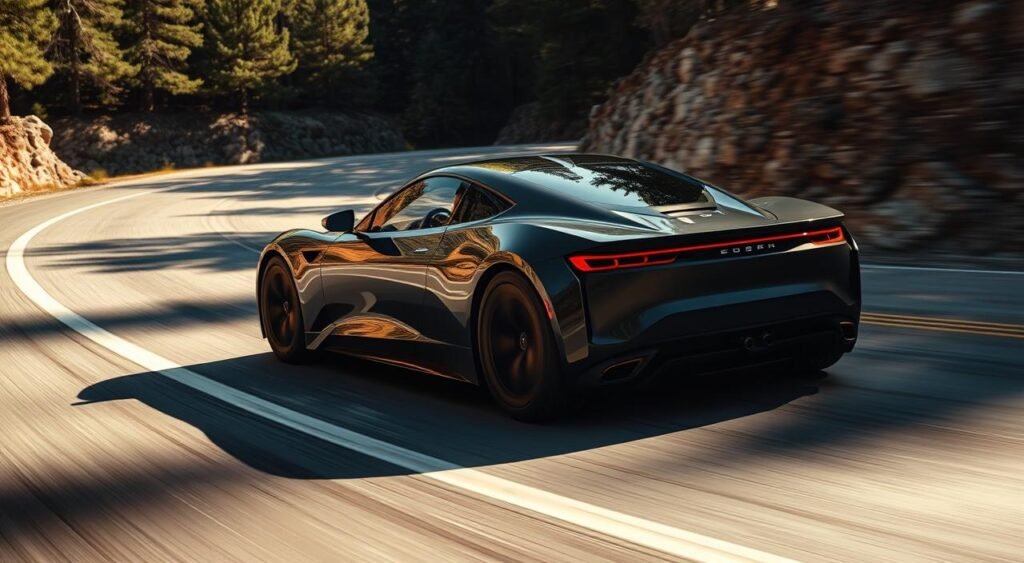
Driving Modes and Controls
The Cyberster has different driving modes. Sport mode boosts performance with quick throttle and stiff suspension. Eco mode saves energy for longer trips. Comfort mode is perfect for everyday driving.
The regenerative braking system is adjustable. Drivers can choose how much energy to recover or how it feels like traditional braking.
Feedback from Early Test Drivers
Test drivers at the Auto Expo 2025 loved the Cyberster. They enjoyed its fast acceleration and smooth handling. They say the electric tech works well with the sports car feel.
Environmental Impact
The MG Cyberster is a big deal for India’s car market. Luxury car sales are growing 3.3% every year. This makes electric cars more important than ever. The Cyberster is an electric car that doesn’t lose the excitement of a furious sports car.
Sustainability of Electric Vehicles
The Cyberster shows it cares about the planet. Its 77kWh battery gives it 580km of range. This means you don’t have to charge it as often.
The inside of the car uses vegan leather. This choice helps the environment even more. Every electric car on the road helps clean the air in cities like Delhi and Mumbai.
Carbon Footprint Reduction
Choosing the Cyberster means no more emissions from cars. Over its life, it saves about 50 tons of CO2. This is a lot less than what gas cars produce.
As India uses more green energy, this effect gets even bigger.
Government Incentives for EV Buyers
Buying an electric car in India comes with perks:
- GST is cut from 28% to 5% on EVs
- You can get up to ₹1.5 lakh off your taxes on EV loans
- States offer subsidies from ₹10,000 to ₹1.5 lakh
- Lower fees for road tax and registration in many places
These benefits make electric cars more affordable for those who want to go green without giving up on performance.
Conclusion and Future Prospects
The MG Cyberster launched at ₹74.99 lakh marks a big change for India’s electric vehicle market. It’s the country’s first electric convertible sports car, blending speed with green tech. MG shows it’s serious about making top-notch EVs affordable for Indians.
Consumer Reception and Market Outlook
People are really excited about the Cyberster, thanks to its tech and sports car vibe. Experts think it could start a wave of high-end EVs in India. If it does well, others might follow with their own premium electric cars.
Upcoming Features and Plans for MG Electric Vehicles
MG is set to grow its electric car lineup in India, with more models coming. They plan to bring in better batteries and more charging spots. The Cyberster might get even better with longer range and new tech features.
Final Thoughts on the Cyberster’s Impact on the Indian EV Market
The MG Cyberster shows electric cars can be thrilling and eco-friendly. With Genesis also eyeing India, competition will drive down prices and improve choices. The Cyberster’s mix of power, style, and value is setting a new standard for electric cars in India.
FAQ
What is the price of the MG Cyberster in India?
The MG Cyberster starts at ₹74.99 lakh for new bookings. Early birds get a ₹2.5 lakh discount, making it ₹72.49 lakh. It’s the cheapest convertible in India right now.
What are the performance specifications of the MG Cyberster?
It has two electric motors for 510hp and 725Nm torque. It goes from 0-100kph in 3.2 seconds and tops out at 200kph. It’s the fastest in its class.
What is the range of the MG Cyberster on a single charge?
It has a 77kWh battery for a 580km range on a single charge. This helps ease worries about running out of charge.
Where can I buy the MG Cyberster?
You can find it at MG’s Select showrooms across India. It will be shown at Auto Expo 2025 before deliveries start.
What luxury features does the Cyberster offer?
It has scissor doors, a soft-top that opens in 10 seconds, and 20-inch wheels. It also has vegan leather, a Bose sound system, wireless connectivity, and advanced safety features.
How does the MG Cyberster compare to other convertibles in India?
It’s India’s first electric convertible. It’s cheaper than the BMW Z4 M40i and Mercedes-Benz CLE 300 Cabriolet. Its electric power gives it a performance edge.
Is the MG Cyberster a practical daily driver?
Yes, it’s designed for performance but is practical too. It has a 580km range, various driving modes, and advanced connectivity. Its soft-top opens in 10 seconds.
What government incentives are available for MG Cyberster buyers?
As an electric car, it might get state and central EV incentives. Benefits differ by state. Check with MG dealers for details.

Aug
Could a Vietnamese electric carmaker change India’s EV scene with its new cars? The world is watching VinFast as it gets ready to enter the Indian market. They will bring two electric SUVs to the table.
VinFast showed off the VF7 and VF6 at the Bharat Mobility Global Expo earlier this year. These electric SUVs have been eagerly awaited by many. The company started taking pre-bookings last month with a deposit of ₹21,000.
Production for both SUVs started this month at VinFast’s new factory in Thoothukudi, Tamil Nadu. The VinFast VF6’s launch in India is a big step for the company. Experts think the official launch will be next month.
The VinFast VF6’s launch in India means new competition in the electric vehicle market. VinFast is bringing new ideas and affordable prices to the table. They want to attract Indian buyers looking for green transportation options.
Key Takeaways
- VinFast prepares to launch two electric SUVs – VF7 and VF6 – in the Indian market
- Pre-bookings opened with a refundable token amount of ₹21,000
- Production started at the new Thoothukudi assembly facility in Tamil Nadu
- Both models were first displayed at the Bharat Mobility Global Expo
- Official launch expected next month as VinFast enters the competitive Indian EV market
- The Vietnamese automaker aims to challenge established electric vehicle manufacturers
Introduction to the VinFast VF6
The automotive world in India is getting a new face. A Vietnamese brand is set to launch a compact electric SUV. The VinFast VF6 comes with cutting-edge tech and sleek design, ready to take on the electric car market.
This brand has put a lot of effort into setting up in India. It has built a state-of-the-art factory in Tamil Nadu. This shows their dedication to making cars locally and helping the environment.
Overview of VinFast as an Automotive Brand
VinFast is Vietnam’s first global car company, all about electric vehicles. It has set up shop in India with a big factory in Tamil Nadu. This move shows they’re serious about making cars here and helping the planet.

The brand showed off its cars at the Bharat Mobility Global Expo. This move shows they’re ready to take on India’s growing electric car market. They mix global know-how with local production.
Significance of the VF6 Model in the Lineup
The VinFast VF6 is an entry-level premium electric SUV. It’s smaller than the VF7 and made for city families who want green cars. It has cool features like advanced connectivity and roomy interiors, making it a great choice for those switching to electric.
| Model | Segment | Target Market |
|---|---|---|
| VF6 | Compact Electric SUV | Urban Families |
| VF7 | Mid-size Electric SUV | Premium Buyers |
Key Features of the VinFast VF6
The VinFast VF6 is a standout in the electric vehicle market. It combines innovative design with advanced technology. Test drives in Noida have shown it’s a stylish and efficient car.
The production-ready model has a unique LED taillight strip and 19-inch alloy wheels. These features improve both looks and performance.
Electric Powertrain Specifications
The electric powertrain of the VF6 offers great performance for everyday use. The exact battery specifications are yet to be confirmed. But, the VF6 promises a good range and fast charging.
The car’s low stance suggests it’s designed for better aerodynamics. This helps the battery last longer. Early reviews say the powertrain is smooth and quiet, like a top electric car.
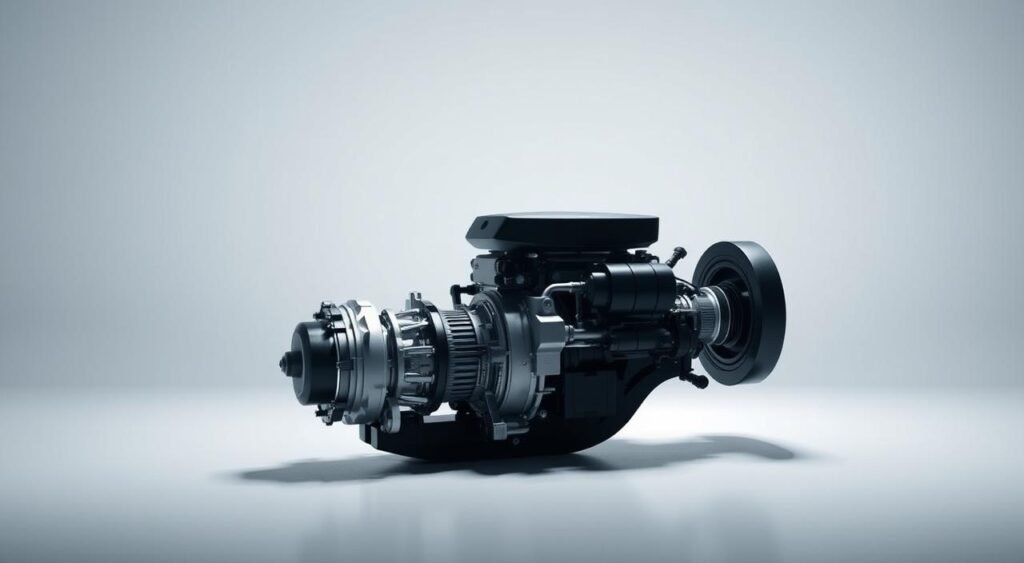
Interior and Technology Highlights
The interior of the VF6 comes in different themes. The Earth variant has an all-black interior. The Wind and Sky trims have a mocha brown and black finish.
There are five exterior colors to choose from:
- Jet Black
- Desat Silver
- Crimson Red
- Zenith Grey
- Urban Mint
Safety Features and Ratings
Safety is a big focus for the VF6. It has advanced driver assistance systems in all versions. The car’s solid build suggests it will protect well in crashes.
When the VinFast VF6 price in India is announced, its safety features will make it a top choice in the electric car market.
Anticipated Launch Timeline in India
The electric vehicle market in India is getting ready for the VinFast VF6. Production has started at the brand’s Tamil Nadu facility. This is a big step for VinFast in India.
Test vehicles have been seen on Indian roads, like in Noida. This shows the final checks are being done.
Expected Launch Date
The VinFast VF6 is expected to launch soon, in the next month. This is because production is almost ready at the Tamil Nadu facility. The car will first be available in big cities and then in smaller ones.
VinFast has moved up its timeline. This is because of successful test runs and getting the necessary approvals.

Pre-Booking Information
People can already book the VinFast VF6. The pre-booking starts with a token of ₹21,000. This is a good deal compared to other electric cars.
| Pre-Booking Feature | Details |
|---|---|
| Token Amount | ₹21,000 |
| Refund Policy | 100% Refundable |
| Booking Channels | Online Portal, Dealerships |
| Priority Delivery | First-come, First-served |
Those who book early will get their car first. VinFast wants to make electric cars easy for Indians to get.
Pricing and Variants of the VinFast VF6
The VinFast VF6 is now in India with a competitive price. It aims to match the prices of other electric SUVs. VinFast will offer several VF6 models to meet different needs and budgets.
Anticipated Pricing Structure
Experts think the VF6’s price will make it a strong contender in the electric SUV market. The base model might cost between ₹35-40 lakhs (ex-showroom). The most advanced version could go up to ₹50 lakhs, competing with the Hyundai Ioniq 5 and Kia EV6.

Variants Available and Their Features
VinFast will have three Earth Wind Sky variants of the VF6. Each is designed for different customer needs. The names show VinFast’s focus on the environment and its commitment to innovation.
| Variant | Key Features | Interior Theme | Estimated Price Range |
|---|---|---|---|
| Earth | Single motor FWD, 201 bhp, 75.3 kWh battery | All-black cabin | ₹35-40 lakhs |
| Wind | Enhanced comfort features, premium audio | Dual-tone mocha brown and black | ₹42-46 lakhs |
| Sky | Dual motor AWD, 349 bhp, advanced ADAS | Dual-tone mocha brown and black | ₹48-50 lakhs |
There are six beautiful colors to choose from: Jet Black, Desat Silver, Crimson Red, Zenith Grey, and Urban Mint. These colors match the VF6’s sleek design and cater to various tastes in India.
Competitive Landscape in the Indian Market
The VinFast VF6 enters a fastest-growing EV market worldwide. Here, big names and newcomers compete fiercely. India’s electric car scene is changing fast, with more people choosing green transport.
The mid-size electric SUV is a hot spot for growth. It’s a key area for car makers to focus on.
Comparison with Rivals in the Electric Segment
The electric SUV segment India is very competitive. VinFast’s VF6 goes up against strong rivals. These cars offer different features and prices.

| Model | Price Range | 0-100 km/h | Key Feature |
|---|---|---|---|
| VinFast VF6 | Expected Rs 35-45 lakh | 5.8-9.5 seconds | Dual-motor option |
| MG Cyberster | Rs 75 lakh | 3.2 seconds | Supercar performance |
| Tata Nano EV | Expected Rs 8-12 lakh | 12+ seconds | Budget-friendly |
Market Trends Influencing EV Purchases
Many things influence what people buy in the mid-size electric SUV market. Government help, like lower GST and subsidies, makes electric cars more appealing. More charging spots in cities help ease worries about running out of power.
Higher fuel costs also push people toward electric cars. Younger folks in cities are choosing electric vehicles for the planet.
Consumer Reaction and Expectations
VinFast’s entry into India has sparked a lot of interest. People are excited about the VF6, with many pre-booking it for ₹21,000. This shows that Indian buyers are eager for new electric cars, beyond Tata and MG.
Initial Public Reception
The VF6 has received positive feedback. Its 450-kilometer range and features have caught many eyes. Customers are also excited about VinFast’s modern design and tech.
Having a local production facility has made buyers more confident. They see it as a sign of VinFast’s long-term commitment to India.
Expected Impact on the Indian EV Market
The VF6’s arrival is a big deal for Indian EVs. It’s making more people think about switching from traditional cars. Experts say VinFast will make the mid-size electric SUV segment more competitive.
This move will also encourage other global EV makers to enter India. But VinFast needs to improve charging and after-sales support to meet high expectations.
FAQ
When is the VinFast VF6 expected to launch in India?
The VinFast VF6 is set to hit the Indian market next month. This follows the start of production at VinFast’s Tamil Nadu facility. Pre-bookings are open with a ₹21,000 token, which is refundable.
What are the VinFast VF6 specs and powertrain options?
Details on the VinFast VF6 for India are yet to be confirmed. Globally, it comes with electric powertrains. The exact specs for India will be shared at launch, promising competitive electric performance.
What variants and features will the VinFast VF6 offer in India?
The VinFast VF6 will likely come in various trims, similar to the VF7. It will feature modern tech, safety systems, and interior options. These include all-black and dual-tone mocha brown and black finishes.
What is the expected VinFast VF6 price in India?
The VinFast VF6’s price in India is yet to be announced. It’s expected to be priced competitively, given its compact electric SUV status and the growing EV market in India.
Where will the VinFast VF6 be manufactured for the Indian market?
The VinFast VF6 will be made at VinFast’s new facility in SIPCOT Industrial Park, Thoothukudi, Tamil Nadu. Production kicked off earlier this month, showing VinFast’s commitment to local manufacturing.
How can I pre-book the VinFast VF6 in India?
Pre-bookings for the VinFast VF6 are open with a ₹21,000 token. You can book through official VinFast channels before the launch next month.
What is the VinFast VF6 availability in India timeline?
The VinFast VF6 is coming soon, with a launch expected next month. Production has started in Tamil Nadu, and test vehicles are on Indian roads. This means deliveries should start soon after the launch.
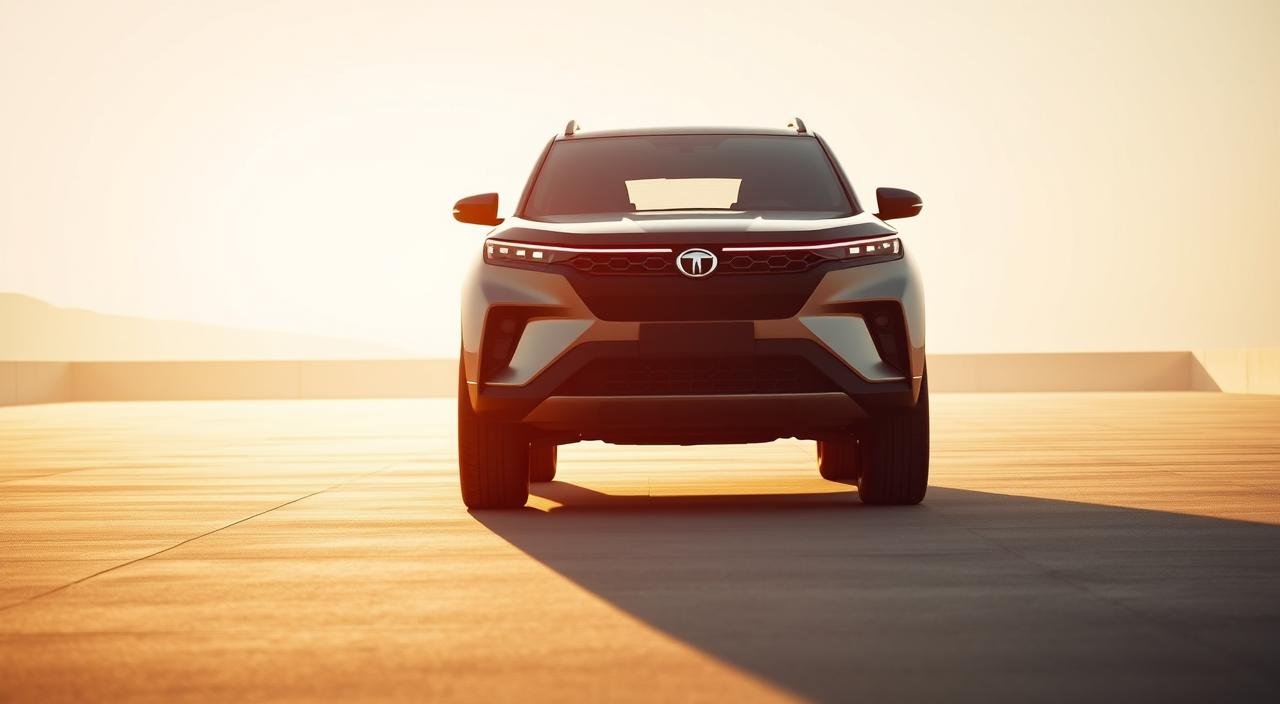
Aug
Is the Tata Harrier EV ready to change India’s electric vehicle scene? Or does it miss the mark? Tata Motors is getting ready to make its popular Harrier electric. The diesel Harrier already impresses with its 2-liter engine, giving 170 PS power and 350 Nm torque.
The Harrier is a standout in the SUV market with its big size. It’s 4,605mm long and has a 2,741mm wheelbase. Starting at Rs 18.99 lakh, it beats rivals like the Hyundai Creta in size and presence. As charging gets better and battery tech improves, the Tata Harrier EV is set to fill a big gap in India’s electric SUV market.
This analysis looks at four key upgrades for the Tata Harrier EV. These changes could make it a top choice in the electric SUV market. Each improvement tackles real concerns for Indian buyers looking for their next electric SUV.
Key Takeaways
- The Tata Harrier EV builds on a proven platform with impressive dimensions exceeding competitors
- Current diesel variants showcase strong performance with 170 PS power and 350 Nm torque
- India’s evolving EV infrastructure creates opportunities for premium electric SUVs
- Four specific improvements could elevate the Harrier EV to segment leadership
- The electric version addresses gaps in India’s premium EV market
- Competitive pricing starting at Rs 18.99 lakh positions it well against rivals
Introduction to Tata Harrier EV
The car world in India is changing fast, with electric vehicles becoming more popular. Tata Motors is ready to make its Harrier SUV electric. This review looks at why the Harrier EV is a big deal in the EV market in India.
Overview of the Tata Harrier EV
The Tata Harrier EV is a big step for the brand in the electric SUV market. It uses the same platform as the diesel Harrier but is electric. It’s for people who want a car that’s good for the planet and doesn’t lose out on comfort or space.
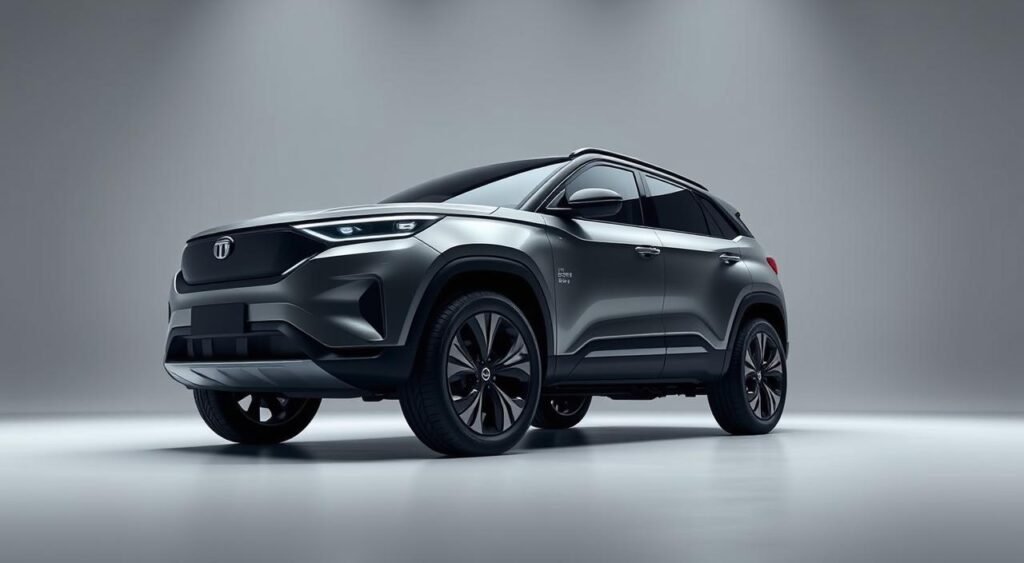
Key Features and Specifications
The Harrier EV has some amazing features:
- Auto-LED bi-projector headlights for better visibility
- Dual 10.25-inch displays for entertainment and info
- Level-2 ADAS for safer driving
- Range of 400-500km, meeting current needs
- Advanced battery system for better efficiency
Market Positioning in India
The Harrier EV is priced between Rs 18.99-20.69 lakh. It’s in a competitive market where people want good value and new ideas. The EV market in India has grown a lot, with better charging and higher range expectations. The Harrier EV meets these needs for city and highway driving.
Design and Aesthetics
The Tata Harrier EV has a bold design that mixes modern looks with SUV toughness. Its exterior styling makes it stand out on the road. The inside is all about comfort and luxury. Let’s see what makes this electric SUV special and how it could get even better.
Exterior Design Elements
The Harrier EV’s exterior is eye-catching, with blacked-out ORVMs and LED turn indicators. Its 17-inch alloy wheels are strong, and the LED taillights add a modern touch. For those who love adventure, there are roof rails for extra practicality.
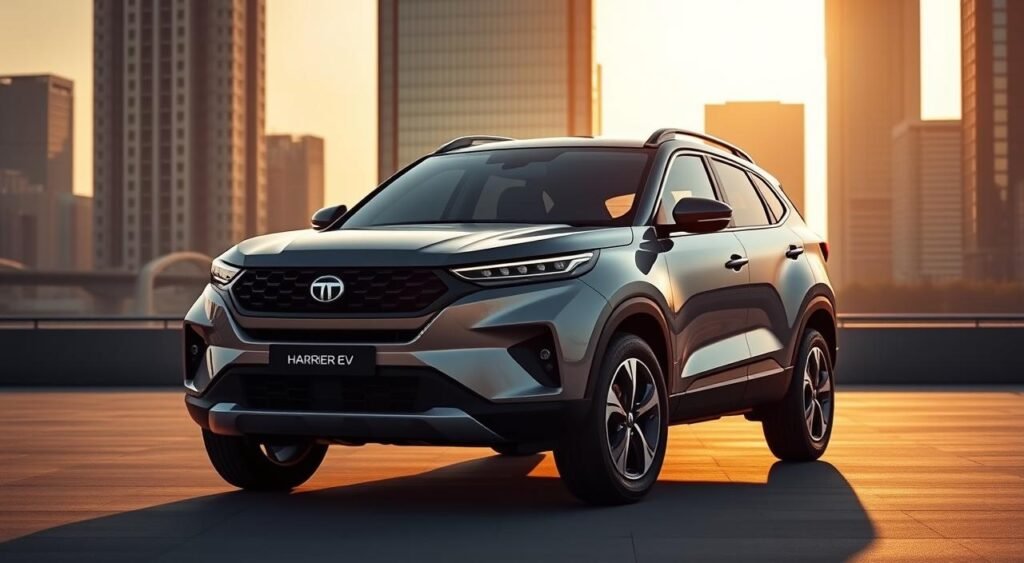
The design focuses on clean lines and being aerodynamic. The front has a closed-off grille, typical of EVs, with sharp LED headlamps. Side cladding adds protection and visual appeal to the profile.
Interior Comfort and Features
Inside, the Harrier EV impresses with black leatherette seats and tan accents. The 4-spoke steering wheel has an illuminated Tata logo, adding a touch of luxury. The two-tone cabin theme makes it welcoming.
- 6-way power-adjustable driver seat
- Spacious legroom surpassing compact SUVs
- Premium leatherette upholstery
- Illuminated brand elements
Color Options and Customization
The Harrier EV comes in several monotone colors to match different tastes. While the colors are good, more customization options could attract more buyers. Competitors like Hyundai Creta offer dual-tone alloy wheels and dynamic turn indicators, showing what’s possible for personalization.
Performance and Driving Experience
The Tata Harrier EV is a big step forward in electric cars. As cars move to electric power, it’s key to know how they drive. The Harrier EV mixes power with efficiency, making it a top choice for electric driving.
Battery Efficiency and Range
Battery tech is key for car performance. The Harrier EV’s battery is top-notch in its class. Electric cars usually get 5-10 km/kWh, depending on the battery and car setup.
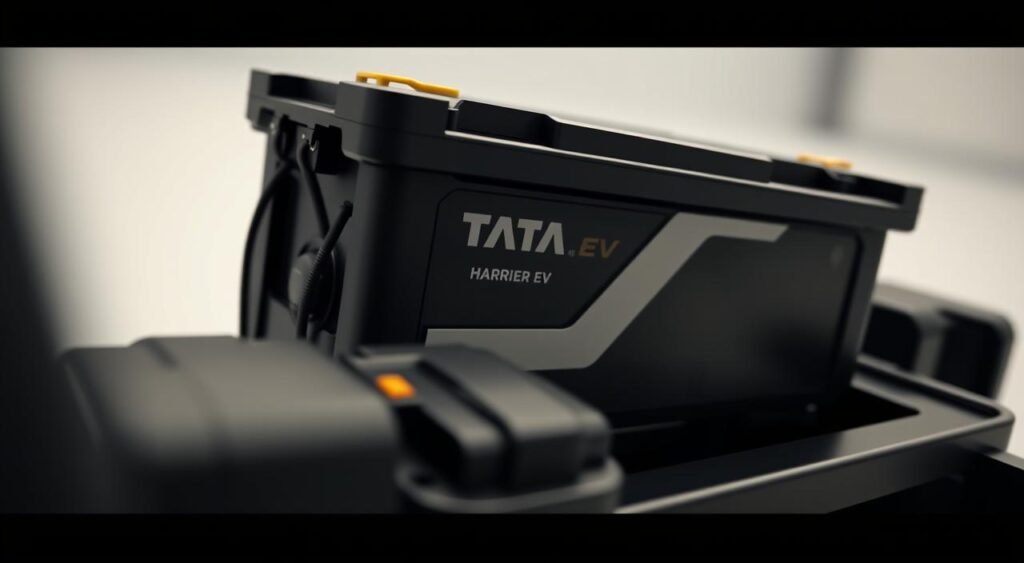
The car’s range changes with how you drive and the battery size. Cars with NMC batteries are often lighter and more efficient. Keeping the battery cool is also important for its performance, no matter the weather.
Handling and Ride Quality
The Harrier EV handles well, perfect for Indian roads. It’s comfy and stable, even when turning. You can adjust how much the car uses regenerative braking to fit your driving style.
How the car is weighted affects how it handles. Cars with the engine in the front are usually easier to handle. Special tires and wheels make the ride smoother and more efficient.
Comparisons with Other EVs
Here’s how the Harrier EV stacks up against other electric cars:
| Model | 0-100 kmph | Battery Type | Efficiency |
|---|---|---|---|
| Hyundai Creta EV | 7.5 seconds | 52kWh NMC | 8-10 km/kWh |
| Mahindra BE6 | 7.0 seconds | 79kWh LFP | 5-7 km/kWh |
These numbers show different ways electric cars are made. Efficiency analysis shows that lighter batteries use less energy, even if they’re smaller.
Technology and Features
The Tata Harrier EV is packed with modern tech to compete with other electric cars in India. It has both useful features and advanced safety systems. Yet, some areas could be better to keep up with the leaders.
Infotainment System and Connectivity
The Harrier Adventure X has wireless Apple CarPlay and Android Auto, along with a 6-speaker sound system. This setup is good for everyday music. It also has front 45W Type-C charging ports and an illuminated glovebox for easy access.
But, some rivals have better audio tech. The Hyundai Creta has an 8-speaker Bose system. The Mahindra BE6 even has a Harman Kardon Dolby Atmos setup, rivaling premium Burmester systems. These systems offer a better listening experience than the Harrier’s.
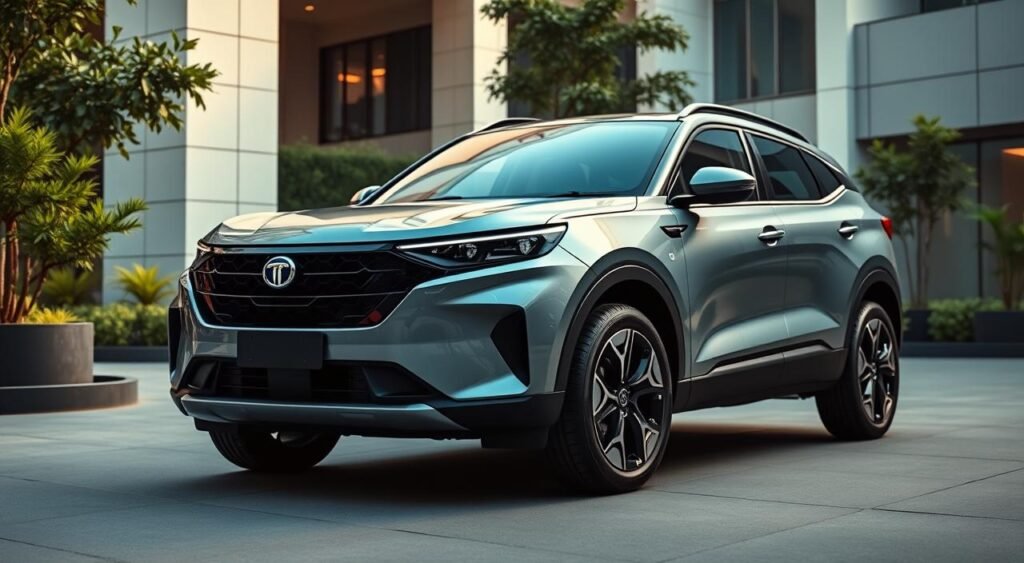
Autonomous Driving Capabilities
The Harrier EV has Level-2 ADAS for highway driving help. It includes:
- Adaptive cruise control for safe distances
- Lane keeping assist for stability
- 360-degree camera system for better visibility
- Rain-sensing wipers for weather adaptability
Some rivals have more features like autopark and blind spot monitoring with cameras. These are chances for the Harrier to improve in the future.
Safety Features and Ratings
The Harrier EV focuses on keeping passengers safe with many safety systems. It comes with 6 airbags, ISOFIX child seat mounts, and electronic stability control. The 360-degree camera system also helps with parking and tight spaces.
| Safety Feature | Tata Harrier EV | Segment Standard |
|---|---|---|
| Airbags | 6 | 6-7 |
| ADAS Level | Level 2 | Level 2 |
| 360° Camera | Yes | Yes |
| Blind Spot Monitoring | No | Available in some |
| HUD Display | No | Available in premium variants |
The Harrier’s safety meets industry standards but could be more unique. Adding features like heads-up display (HUD) and better blind spot monitoring would make it stand out more in the EV market.
Conclusion: The Path Forward for Tata Harrier EV
The Tata Harrier EV is at a turning point. The Indian electric SUV market is growing fast, with cars like MG ZS EV and Hyundai Kona Electric leading the way. To succeed, the Harrier EV must offer great value at a competitive price. It has a strong base thanks to Tata’s reputation and roomy design, but it needs to do better to win over customers.
Addressing the Shortcomings
The Harrier EV has some key areas to work on. It needs to get better mileage than 8 km/kWh to keep up with the competition. Improving the battery management system is a top priority. Tata Motors also needs to grow its EV service network in big cities.
The car’s throttle needs to be smoother, matching the quick power of electric cars. This is what buyers want.
Future Updates and Improvements
Upcoming updates will add features like ventilated seats and climate control. Wireless charging will also be added. The goal is to make the Harrier EV fast, accelerating from 0-100 kmph in under 8 seconds.
Long-distance travel is a big deal, so a range of 400+ kilometers is essential. Adding advanced safety features will make the car more appealing to tech lovers.
Final Thoughts on Market Position
The Harrier EV has a real chance to shake up the Indian electric SUV market. It has a lot going for it, like a solid feature list and a reliable platform. But, it must fix its current issues and keep its price competitive.
India’s growing EV infrastructure is a big plus for new players. With the right updates and a smart marketing strategy, the Harrier EV could become a top choice in this fast-growing field.
FAQ
When will the Tata Harrier EV launch in India?
Tata Motors hasn’t set a launch date for the Harrier EV yet. But, they’ve shown they can do it with the current Harrier. The diesel versions have cool features that could work well in an electric car as India’s EV setup gets better.
What is the expected price range for the Tata Harrier EV?
The Harrier diesel costs between Rs 18.99-20.69 lakh. EVs in the same class cost between Rs 17.99-25.72 lakh. So, the Harrier EV should be priced to compete with the Hyundai Creta EV and Mahindra BE6.
What range can we expect from the Harrier EV?
People want EVs to go 400-500km in real life. The Harrier EV should aim for 8-10 km/kWh efficiency. It might need a 50-60kWh battery pack to keep up.
How does the Harrier’s size compare to other electric SUVs?
The Harrier is bigger than the Hyundai Creta, with a length of 4,605mm and a wheelbase of 2,741mm. It has more room inside, making it a strong contender in the electric SUV market.
What advanced features does the current Harrier offer that could transfer to the EV version?
The Harrier has Level-2 ADAS, a big touchscreen, and a digital display. It also has a 360-degree camera and wireless CarPlay/Android Auto. The EV version might get even more tech, like better regenerative braking.
What improvements would the Harrier EV need to compete effectively?
To beat the competition, the Harrier EV should have ventilated seats and dual-zone climate control. It should also accelerate fast and be very efficient. Plus, it needs better battery management and smooth braking.
How does Tata’s service network compare for EV support?
Tata Motors has a big service network in India. But, they need to make sure their EV service is top-notch. They should train their techs well and have good charging support at service centers.
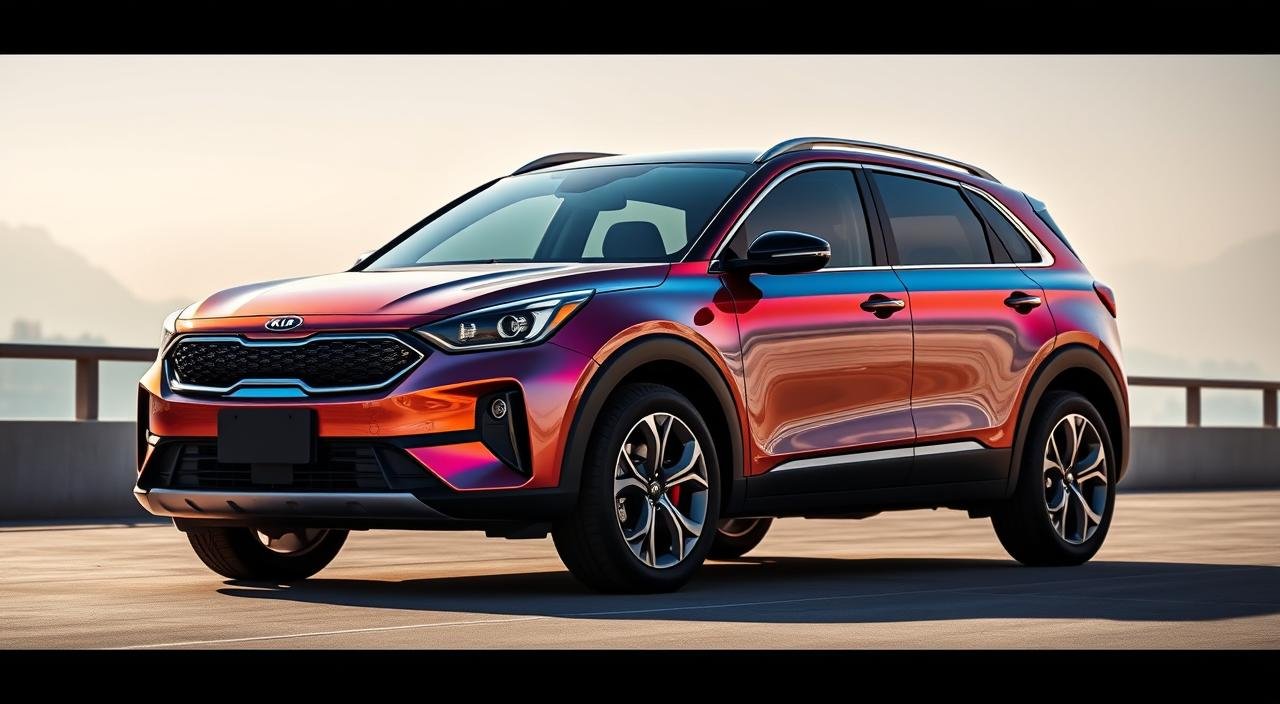
Aug
Can an electric MPV really meet the needs of Indian families? The Kia Carens Clavis EV is now in the Indian market. Families are looking for electric cars as a good alternative to gas cars.
The Kia Carens Clavis electric is a big step for the brand. This review looks at everything important for Indian buyers. It covers technology, performance, and what you need to know.
Electric cars in India have their own set of challenges. Things like road conditions, charging spots, and weather affect EVs. The Kia Carens Clavis EV needs to do well in these areas to stand out in the MPV market.
This review goes into detail about owning an EV. It talks about battery life, safety, and how it works in daily life. It aims to help families make the right choice for their next car.
Key Takeaways
- The Kia Carens Clavis EV targets Indian families seeking spacious electric mobility solutions
- Comprehensive analysis covers technology, performance, safety, and real-world ownership aspects
- Electric MPV segment presents unique opportunities and challenges in the Indian market
- Detailed examination includes battery life, charging capabilities, and practical daily use considerations
- Expert opinions and owner feedback provide balanced perspectives on vehicle strengths and limitations
- Assessment helps buyers understand if the electric variant meets their specific family needs
Overview of the Kia Carens Clavis EV
The Kia Carens electric vehicle is a big step for India’s EV market. It’s a three-row family car that’s good for the planet. It’s built on a modern electric platform, bringing new tech to India’s electric MPV market.
Key Features and Specifications
The Kia Carens EV has advanced battery tech for Indian weather. It has many charging options and smart energy systems. Here’s what makes it stand out in the electric car world:
| Specification | Details |
|---|---|
| Battery Capacity | 58 kWh Lithium-ion |
| Range (ARAI) | 425 km |
| Charging Time (Fast) | 0-80% in 45 minutes |
| Seating Capacity | 6/7 seats |
| Motor Type | Permanent Magnet Synchronous |
Design and Aesthetics
The outside has Kia’s tiger-nose grille, made for electric cars. LED lights run from front to back, giving it a cool look. It’s aerodynamic, but it’s also big inside for families.

Inside, it’s all about luxury. The dashboard and seats are top-notch. It has three rows for flexible seating. At night, the lights make it feel cozy.
Performance Metrics
The Kia Carens Clavis EV performance is top-notch for daily use. It has a 150 PS electric motor and 255 Nm of torque. This means it’s fast in the city and smooth on the highway.
It goes from 0-100 km/h in 9.5 seconds. And it’s very efficient, meeting India’s standards.
Technology and Infotainment
The Kia Carens Clavis EV is packed with modern tech for families. It’s a three-row SUV with cool features for drivers and passengers. The infotainment system makes it easy to stay connected without hassle.
Advanced Connectivity Options
The heart of the Kia Carens EV is its 8-inch touchscreen. It supports wireless Android Auto and Apple CarPlay, so you don’t need cables. Plus, it gets updates online, so you don’t have to go to the dealership.
With connected car tech, you can check on your car from anywhere. You can see the battery status, warm up the car, and find it. These features help with range worries and getting comfy before you start driving.
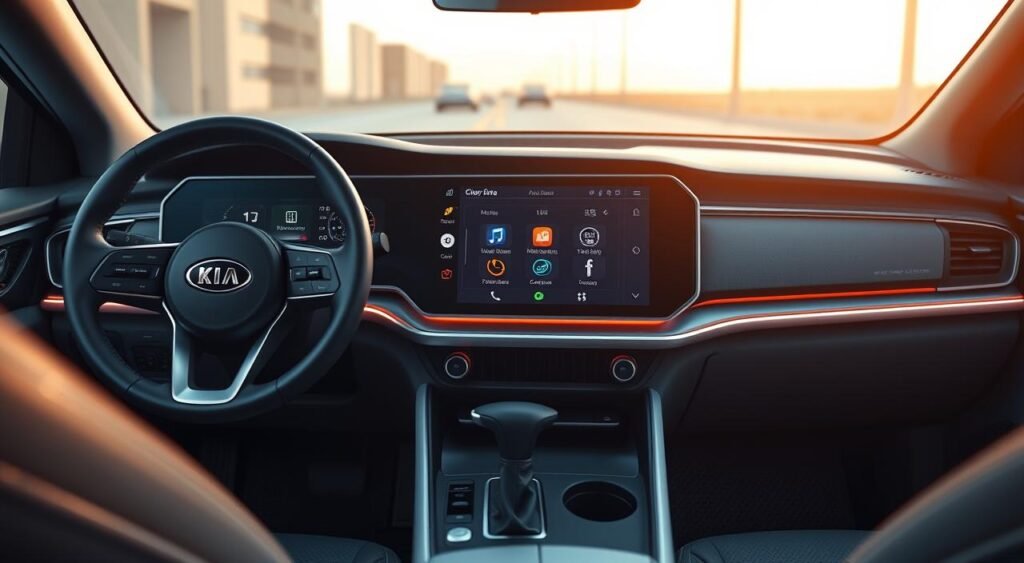
User Interface Experience
The digital dashboard shows important info like battery charge and range. You can use voice commands for navigation and music. The design is simple, so it doesn’t distract you from driving.
Sound System Quality
The sound system is top-notch for family fun. It’s set up to block out road noise. Plus, there’s automatic climate control and rear AC vents for everyone’s comfort.
Safety Features and Ratings
The Kia Carens Clavis EV focuses on keeping passengers safe with top-notch safety systems. It’s designed for the roads in India. It has both passive and active safety features for full protection. It also has modern driver assistance tech, making it a standout in the Kia Carens Clavis EV comparison.
Crash Test Results
The car is built strong with high-strength steel. It also has a special battery protection system. Indian crash test agencies have checked it out.
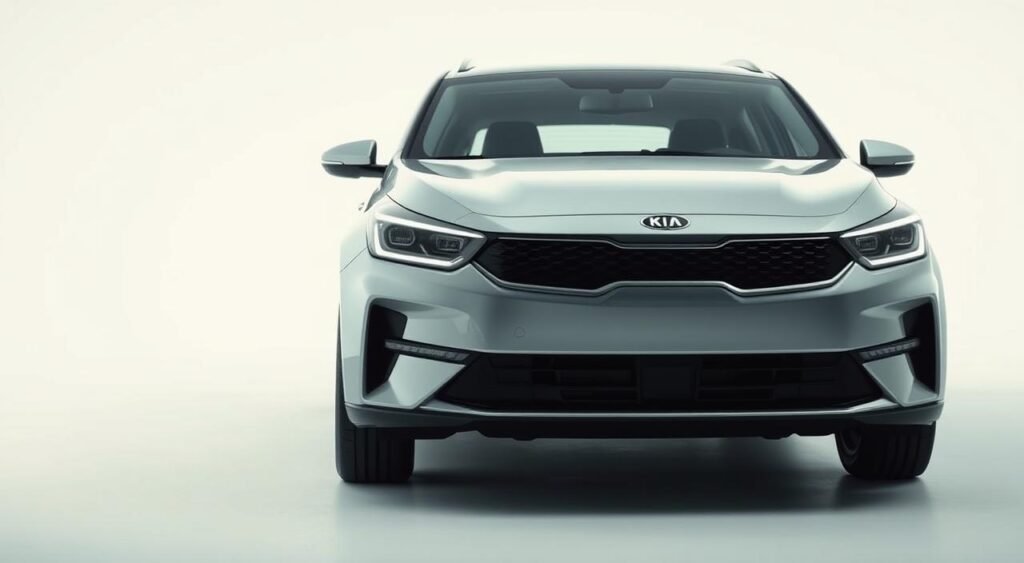
It comes with six airbags for safety. It also has ABS and EBD for better braking. Plus, ESC helps prevent skidding.
Driver Assistance Technologies
The Kia Carens EV review talks about its advanced safety features. These include:
- Autonomous emergency braking for collision prevention
- Lane keeping assist to prevent unintended lane departures
- Blind spot monitoring for safer lane changes
- Adaptive cruise control for highway driving
- Traffic sign recognition system
It also has hill-hold assist and parking sensors. ISOFIX child seat mounting points are there for child safety. These features help with semi-autonomous driving while keeping the driver in control.
Performance Analysis
The Kia Carens Clavis electric is great for city driving and long trips. Its electric power makes it quick and efficient. Let’s look at how it performs in real driving.
Acceleration and Speed
The electric motor gives instant power, speeding up from 0-100 kmph fast. This makes it easy to pass other cars and get onto highways. Unlike cars with gears, the Kia Carens Clavis electric keeps its speed steady.
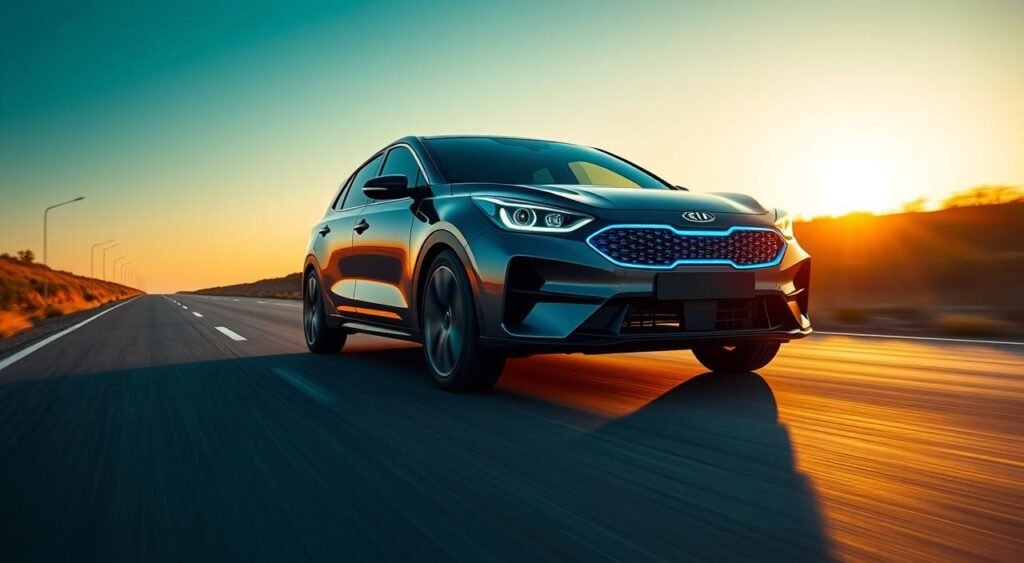
Battery Life and Charging
The battery pack gives enough range for daily use. It uses energy wisely. Fast charging gets it to 80% in under an hour at the right stations. The Kia Carens EV has:
- Multiple driving modes for better efficiency
- Regenerative braking to save energy
- Smart battery thermal management
- Works with standard AC home charging
Handling and Ride Comfort
The suspension is perfect for comfort and control. It smooths out bumps and keeps the car stable. The low battery position makes it handle better. The Kia Carens Clavis electric rides well on all kinds of roads.
Customer Feedback and Reviews
People in India share their real-life experiences with the Kia Carens electric vehicle. They talk about its good points and what could be better. Families love the roomy interior and smooth electric drive. Experts also give their thoughts on this EV, focusing on its family-friendly features.
Owner Experiences
Families say the Kia Carens Clavis EV is great for daily trips. They like how it’s built and how comfy it is inside. The car’s range is around 250-320 kilometers, depending on how you drive it.
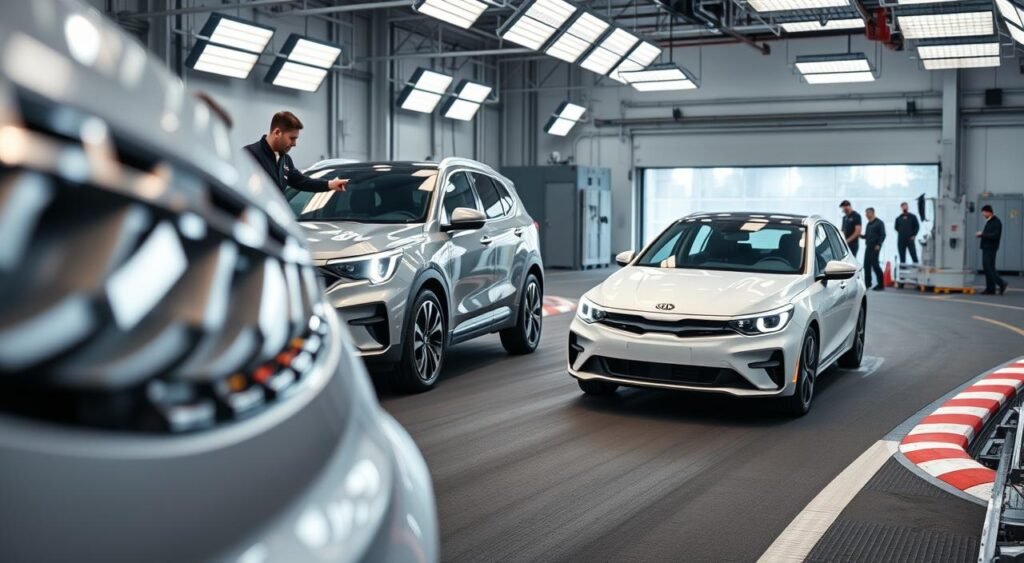
Expert Opinions
Car critics say the Kia Carens is a good deal for its price. They like how it keeps its cool in hot weather. The car’s quick start and quiet ride are big pluses. It’s a strong contender in the Indian EV market.
Common Complaints
One big issue is the lack of charging spots in smaller cities. Buying one costs more than regular cars, about 40-50% more. Some worry about finding service centers in rural areas.
| Feedback Category | Positive Aspects | Areas of Concern |
|---|---|---|
| Interior Space | 7-seater configuration, Premium materials | Third-row access |
| Performance | Instant torque, Silent operation | Highway range anxiety |
| Cost Analysis | Low running costs, Tax benefits | High upfront investment |
| Charging | Home charging convenience | Public infrastructure gaps |
Conclusion: Evaluating the Kia Carens Clavis EV
The Kia Carens Clavis EV is a great choice for Indian families. It combines modern tech with lots of space. Looking at its features, we see its good points and areas for improvement.
Pros and Cons Summary
The Kia Carens Clavis EV has many strengths. It offers room for big families and comes with the latest safety features. It’s built well, just like Kia’s other cars. Its electric range is perfect for city driving.
But, there are some things to think about before buying. It costs more than some petrol cars. Charging spots are hard to find in many places. It’s not the fastest car, and long trips need careful planning.
Final Thoughts and Recommendations
Think about your daily drive and charging options before buying. The Kia Carens Clavis EV is best for families with regular commutes and easy access to charging. It’s a smart choice for those who want to save money and the planet.
FAQ
What is the real-world range of the Kia Carens EV in Indian driving conditions?
The Kia Carens EV’s range varies based on how you drive and the weather. Official numbers give a standard range, but real-life performance changes. Things like traffic, climate control, and driving style affect it.
Driving in cities with lots of stops cuts down the range. But, driving on highways at moderate speeds helps the battery last longer. Extreme temperatures in India can reduce the battery’s performance by 15-20%.
How does the Kia Carens Clavis EV compare to conventional Carens variants in terms of total ownership cost?
The Kia Carens Clavis EV costs more upfront but saves money over time. It doesn’t need fuel or oil changes, saving on maintenance. Government incentives in India also help make it more affordable.
On average, the EV breaks even in 4-5 years. This is based on typical driving in India.
What are the main Kia Carens EV issues reported by owners?
Owners worry about charging in smaller cities. There’s a lack of fast-charging spots on highways. The high initial cost is also a concern for those on a budget.
Training for EV maintenance varies by location. But, Kia is working to improve its service network.
What are the key Kia Carens EV features that justify the premium pricing?
It comes with advanced safety features like six airbags and ESC. It also has ADAS, including emergency braking and lane assist. The 8-inch touchscreen with wireless Android Auto and Apple CarPlay is a big plus.
It has connected car tech and over-the-air updates. Premium features include LED lights, automatic climate control, and a digital instrument cluster. The electric powertrain offers a smoother drive than gas models.
How does the Kia Carens Clavis EV performance handle Indian road conditions?
The Kia Carens EV rides well on Indian roads thanks to its suspension. Its electric motor gives quick acceleration in traffic. It has different driving modes for performance or efficiency.
The low battery pack improves stability. But, it’s important to consider ground clearance, mainly during the monsoon.
What are the Kia Carens EV specifications for charging compatibility?
It supports DC fast charging, making it quick to charge. The battery system manages charging rates for long battery life. It’s compatible with various charging standards in India, including CCS2 for fast charging.
Home charging options include portable and wall-mounted units. The charging port and cable system make it easy to charge in Indian parking.
Is the Kia Carens Clavis EV suitable for large Indian families?
Yes, it has a three-row seating for seven people. It’s great for big families. The interior is spacious and comfortable, with USB ports for everyone.
The flat floor design makes middle-row seats more comfortable. There’s enough room for luggage, even with all seats full. ISOFIX mounting points safely fit child seats in various positions.
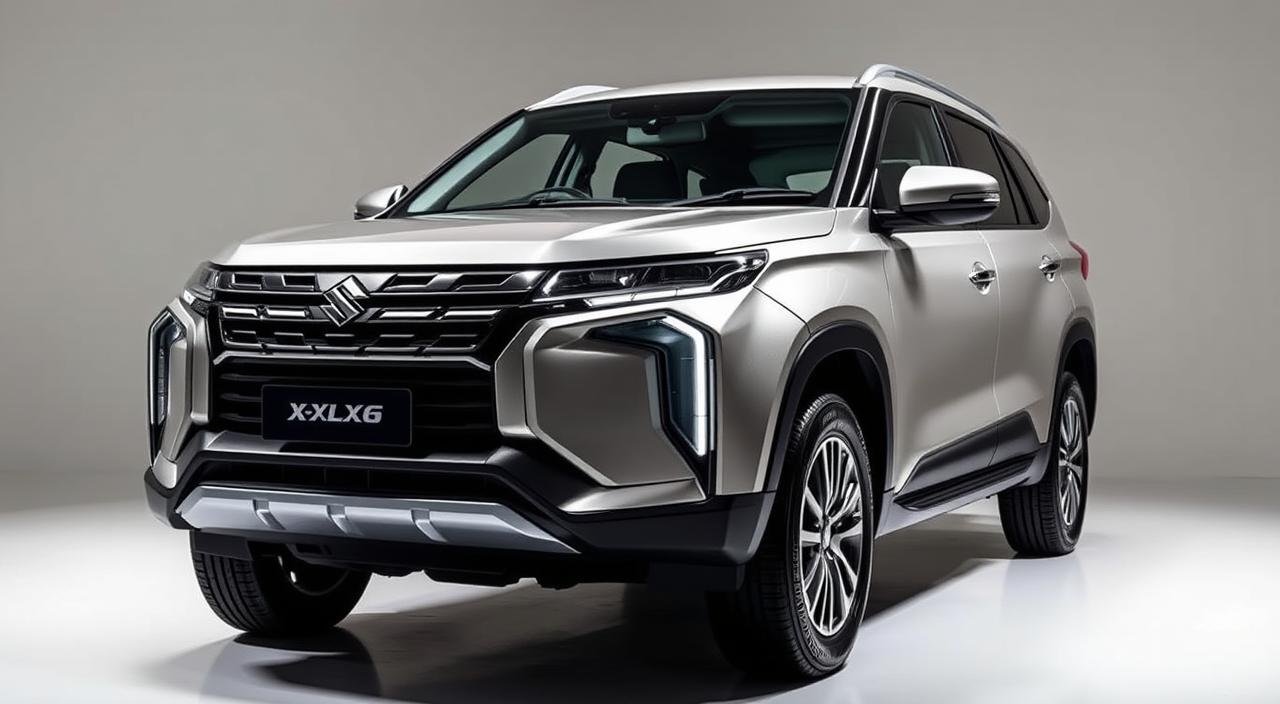
Aug
Is it worth paying more for safety features? The Maruti XL6 now comes with 6 airbags as standard. This upgrade costs up to Rs 41,000 more, making some wonder if it’s worth it.
The Indian car market is changing fast. Now, car makers focus more on safety. Maruti Suzuki has made the XL6 safer by adding six airbags to all models. This move is similar to the update on the Fronx model, showing Maruti’s dedication to keeping passengers safe.
More people in India want cars that are safer. The price increase for these safety features makes some question if it’s fair. But, car makers must follow new rules to make cars safer. The Maruti XL6 now meets these standards with its advanced airbag system.
Key Takeaways
- The Maruti XL6 now includes 6 airbags as standard equipment across all variants
- Prices have increased by up to Rs 41,000 following the safety enhancement
- This update follows similar safety improvements made to the Fronx model
- The Indian automotive market is experiencing increased focus on standard safety features
- Consumer demands and regulatory requirements are driving these safety upgrades
- The price hiked reflects the cost of implementing a full safety system
Introduction to the Maruti XL6’s New Features
The Maruti XL6 has seen a big upgrade, focusing on keeping passengers safe. This update adds key safety features to all models. It shows a big change in how car safety is viewed in India.
The popular MPV now offers better safety without losing its value and practicality.
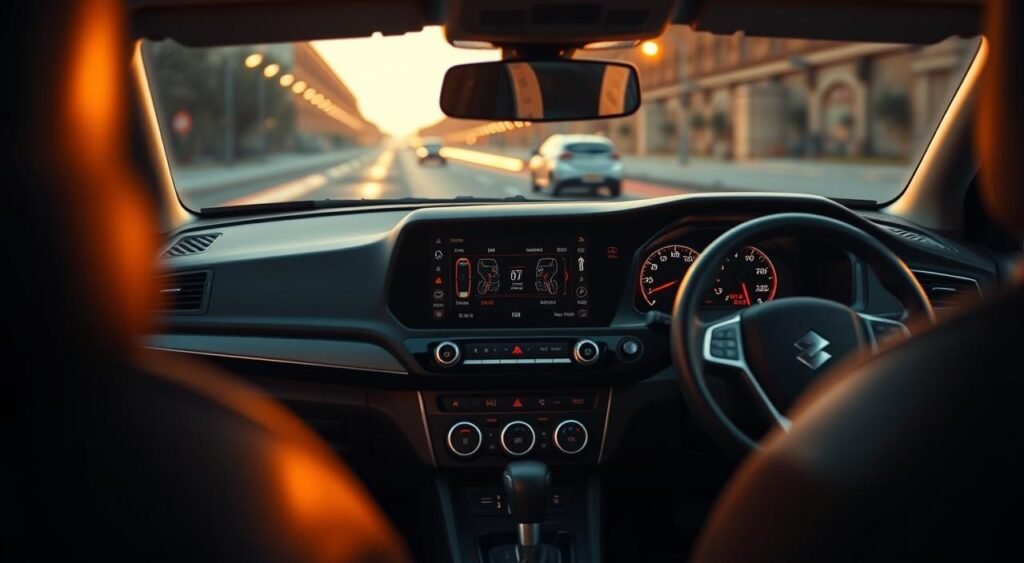
Overview of the Latest Updates
The biggest change is the airbag setup. Now, all XL6 models come with six airbags as standard. This includes front, side, and curtain airbags for all three rows.
It also has Electronic Stability Program (ESP) and hill hold assist for all.
Significance of Standard Airbags
Having six airbags as standard is a big leap for the Maruti XL6. Before, only higher models had more airbags. Now, every XL6 buyer gets the same safety, no matter the trim.
This move meets global safety standards and answers growing concerns about safety in India.
Impact on Consumer Safety
These new safety features greatly benefit families who use the XL6. Airbags now cover all seats, reducing injury risks in crashes. Parents can feel safer with kids in the third row, thanks to curtain airbags.
This focus on safety makes the Maruti XL6 a strong choice in the MPV market.
Pricing Changes and Their Implications
The Maruti XL6 has seen a big price change. This is because it now comes with six airbags as standard in all models. This shows the brand’s dedication to safety, but it also makes the car more expensive.
Breakdown of Price Hike
The price increase is up to Rs 41,000 for different XL6 models. This change is because of the added safety features. Now, the XL6 is priced well in the MPV market, where safety matters a lot.
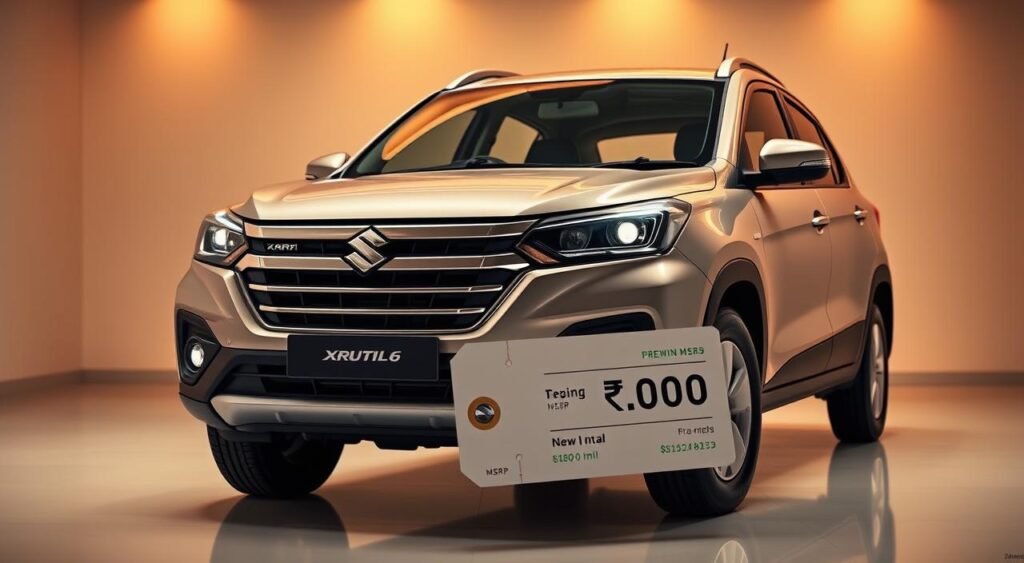
Comparison with Previous Models
The new XL6 is pricier than before. Prices in the MPV market vary, from Rs 5.78 lakh to Rs 7.50 lakh. Despite the higher cost, the XL6 is seen as a good deal because of its safety features.
Market Reaction
People are generally happy with the new XL6’s price. Dealers say they’re getting a lot of interest. The brand’s success, hitting 30 lakh sales by May 2023, shows it’s trusted by many.
Customers are okay with paying more for safety. They see it as a smart choice, not just an extra cost.
Enhanced Safety Features of the Maruti XL6
Maruti Suzuki has made a big leap in making passenger safety a top priority. They’ve made 6 airbags standard in all XL6 models. This shows their dedication to safety without making customers pay more for it.
Details of the 6 Airbags System
The XL6’s airbag system offers protection in all directions. It has dual front airbags for the driver and passenger, side airbags for the front seats, and curtain airbags for the windows. This setup protects against frontal, side, and rollover impacts.
Other Safety Measures Included
The XL6 also has other vital safety features. These work together to prevent accidents and reduce injuries. The vehicle includes:
- ABS (Anti-lock Braking System) with EBD for controlled braking
- Electronic Stability Program for better vehicle control
- Hill Hold Assist to prevent rollback on slopes
- ISOFIX child seat anchors as standard
- Reverse parking sensors with camera
Importance of Comprehensive Safety Features
Maruti’s decision to include these safety features as standard shows they understand Indian roads and customer needs. With more people focusing on safety, these features are now seen as must-haves. The XL6’s safety package makes it a strong contender in the MPV market, where family safety is key.
Competitor Analysis in the MPV Segment
The premium MPV market in India is getting more competitive. Safety features are key for buyers. The Maruti XL6 competes with established players, each with their own value.
Key Rivals of the XL6
The Maruti XL6 faces tough competition in the Indian market. Its main rivals are:
- Kia Carens – A feature-rich MPV with modern styling
- Mahindra Marazzo – Known for spacious interiors and robust build
- Toyota Innova Crysta – Premium positioning with proven reliability
- Renault Triber – Budget-friendly option with flexible seating
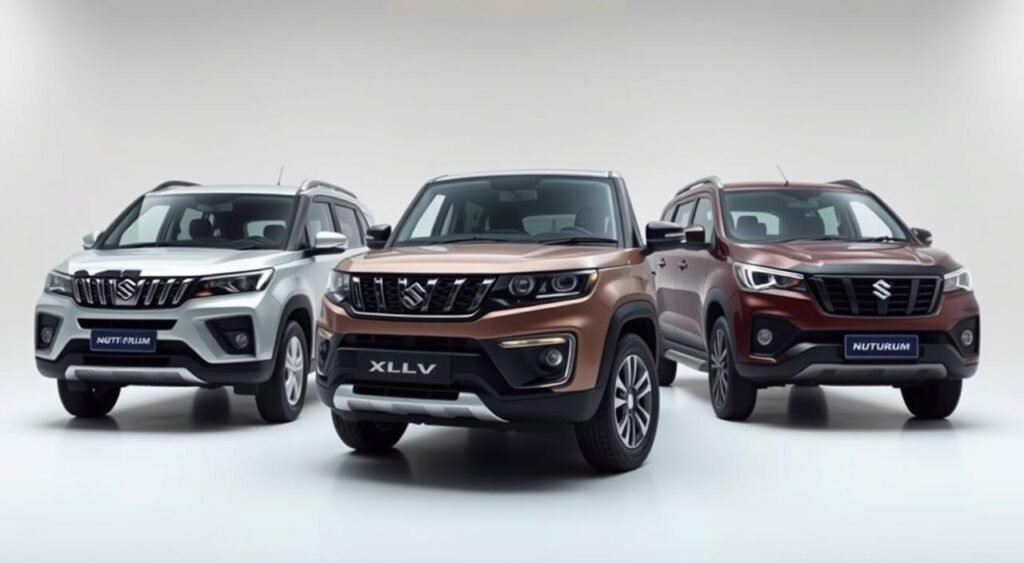
How Does XL6 Compare With Rivals?
The latest update makes the Maruti XL6 a strong contender in safety. It now comes with six airbags, matching Kia Carens. The XL6 also has Maruti’s wide service network and good fuel efficiency.
Its refined petrol engine offers smooth driving on both city and highway roads.
Market Positioning
The Maruti XL6 finds a balance between budget and premium MPVs. It’s priced to appeal to families looking for safety, comfort, and reliability. The latest update shows Maruti’s dedication to safety while keeping prices reasonable.
This approach has helped Maruti keep its sales strong in the competitive MPV market.
Customer Reactions and Feedback
The Maruti XL6 now comes with six airbags as standard. This has started a big talk among car buyers in India. People are talking about the price going up and the safety features getting better.
Early Responses from Drivers
Maruti XL6 owners are happy with the new safety features. They like how the brand is focusing on keeping passengers safe. Online and social media are full of good comments about the airbag upgrade.
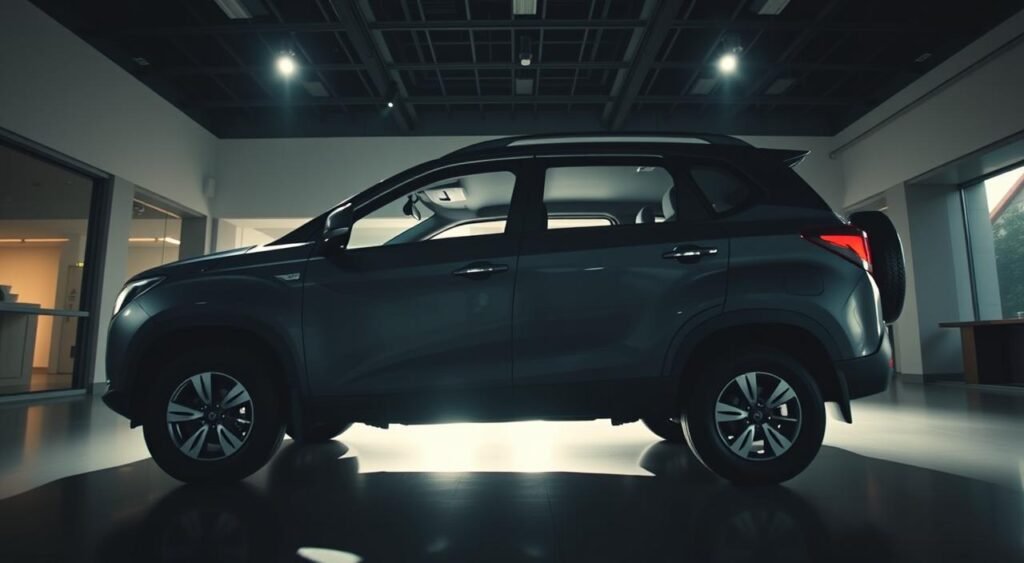
Safety Concerns Addressed
Some buyers were worried about airbag coverage before. The new safety features fix this problem. Families are really happy with the six airbags in the Maruti XL6.
Overall Sentiment toward Price Hike
People’s reactions to the price change are interesting:
| Customer Segment | Response to Price Increase | Purchase Intent |
|---|---|---|
| First-time Buyers | Slightly Concerned | 70% Positive |
| Upgrade Buyers | Accepting | 85% Positive |
| Safety-Conscious Families | Very Supportive | 92% Positive |
Indian buyers are starting to see safety as more important than a little extra cost. This change shows they care a lot about keeping everyone safe in cars.
Future Prospects for the Maruti XL6
The Maruti XL6 is at a key point in India’s car market. It’s ready to meet new safety standards and what people want. This makes it a great choice for families looking for safety and value.
Potential Market Trends
The car market in India is moving towards safer, more affordable vehicles. The Maruti XL6 is a perfect fit with its 6-airbag setup. Experts say more people will want safe cars, even in the mid-range.
This trend helps the XL6. Families want cars that are safe and practical.
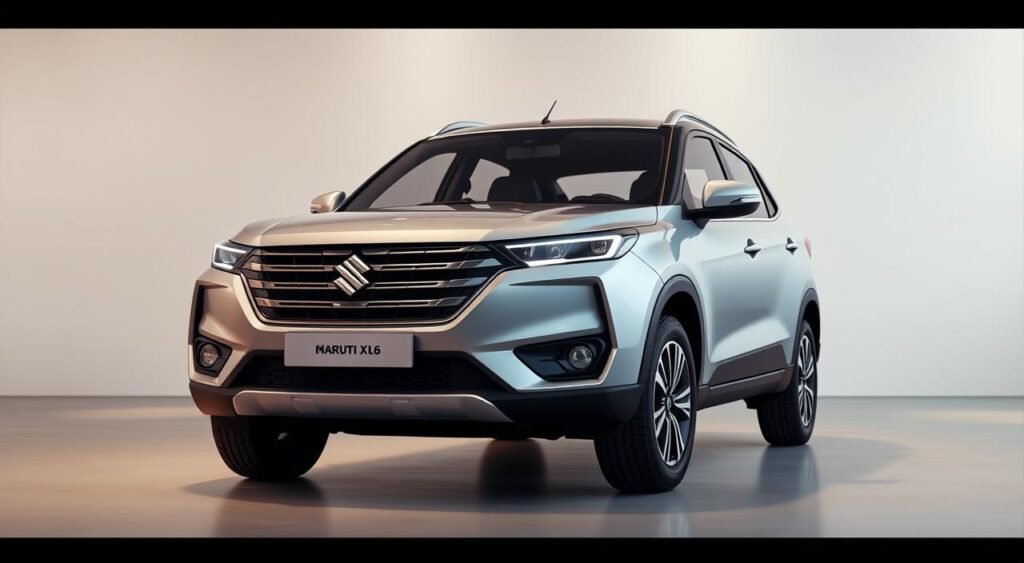
Expected Updates and Releases
Suzuki Motor Corporation is dedicated to improving its cars for local markets. The Maruti XL6 might see updates like:
- Improved fuel efficiency
- More advanced driver aids
- Better infotainment systems
- Hybrid or CNG options
These changes will keep the XL6 competitive. It will remain a top choice for families in India.
Long-Term Consumer Trust in Maruti
Maruti has been a trusted brand in India for years. Making 6 airbags standard on the XL6 shows they care about safety. Consumer confidence remains high because Maruti offers good value and features.
This trust leads to strong resale values. It also keeps the Maruti XL6 at the top of the market.
Conclusion: Is the Price Hike Worth It?
The Maruti XL6 now comes with 6 airbags standard, a big change in safety for MPVs. This upgrade costs Rs 41,000 more, a price increase buyers need to think about. It’s a trade-off between more safety and spending more money on a popular seven-seater car.
Balancing Safety and Affordability
The price hike for 6 airbags changes how buyers see the XL6. While Rs 41,000 is a lot, it covers all passengers in three rows. This makes the XL6 as safe as pricier cars in crashes. For families who value safety, the extra cost is worth it.
Final Thoughts on the XL6’s Upgrades
Maruti’s move to standard 6 airbags shows a shift in safety needs in India. The company’s success, like hitting 1 million Wagon R sales by 1998, shows it’s reliable. The XL6’s upgrade means it’s a smart choice for families who want safety.
Recommendations for Prospective Buyers
Those looking at the Maruti XL6 should see the price hike as an investment in safety. The 6 airbags give peace of mind, even if it costs more. If budget is tight, look into financing. Test driving and comparing with others will help decide. The XL6 is a solid choice for families wanting safety without going premium.
FAQ
What is the price increase for the Maruti XL6 after adding 6 airbags as standard?
The Maruti XL6 prices have gone up by up to Rs 41,000. This is because six airbags are now a standard feature in all models. The cost of these advanced safety features is reflected in the price increase.
Which variants of the Maruti XL6 now come with 6 airbags?
All variants of the Maruti XL6 now have six airbags as standard. No matter which trim you choose, you get the same level of airbag protection for everyone.
What safety features does the 6-airbag system include?
The six-airbag system protects the driver and front passenger. It also includes side impact airbags. The XL6 also has ABS, EBD, and seat belt warnings for extra safety.
How does the Maruti XL6’s safety update compare to other Maruti models?
The XL6 is similar to the Maruti Suzuki Fronx, which also got six standard airbags. This shows Maruti’s focus on making all their cars safer for everyone.
Is the Rs 41,000 price increase justified for the safety features?
The price hike is worth it for the extra safety it brings. With more people wanting safe cars, this update is a big step forward in protecting passengers.
How does the XL6 compete in the premium MPV segment after this update?
With six airbags as standard, the XL6 is now a stronger contender in the premium MPV market. It meets the growing demand for safety and keeps up with the competition.
What other Maruti models have achieved significant sales milestones?
The Maruti Wagon R has been a huge success, selling over 1.90 lakh units in 2024. It has reached 30 lakh sales in India and 10 million globally, showing Maruti’s strong market position.
Will there be future updates to the Maruti XL6?
Suzuki Motor Corporation plans to keep improving the XL6 to meet local needs and safety standards. The car industry is moving towards more standard safety features, so we can expect more updates.

Aug
Is the Toyota Fortuner NeoDrive the game-changing SUV that Indian buyers have been waiting for, or does it fall short of expectations?
The Toyota Fortuner NeoDrive is a big update in Toyota’s SUV lineup for India. It comes at a time when SUV buyers want more features, better tech, and value. The NeoDrive tries to meet these needs while keeping the Fortuner’s good name.
Indian car buyers now look for SUVs with premium features at affordable prices. The Toyota Fortuner NeoDrive review shows Toyota’s choices to balance cost and features. Some new features will thrill buyers, but others might leave loyal fans a bit sad.
The NeoDrive brings new tech, design updates, and better safety. But, it misses some features that fans were hoping for. This deep dive into the NeoDrive variant looks at what Toyota did right and what they might have missed.
Key Takeaways
- The Toyota Fortuner NeoDrive introduces selective upgrades targeting Indian market preferences
- New technology features aim to compete with rivals in the premium SUV segment
- Some popular features from previous variants have been removed to control pricing
- Design updates give the NeoDrive a fresh appearance while maintaining brand identity
- Safety enhancements align with new Indian automotive regulations
- The variant positions itself between base and top-spec models in the Fortuner range
Overview of the Toyota Fortuner NeoDrive
The Toyota Fortuner NeoDrive is a new version of India’s favorite SUV. It brings advanced technology to the powertrain. This version keeps the Fortuner’s reliability but adds modern efficiency.
It’s built for India’s roads, keeping the legendary capability. But it also brings big improvements for daily driving.
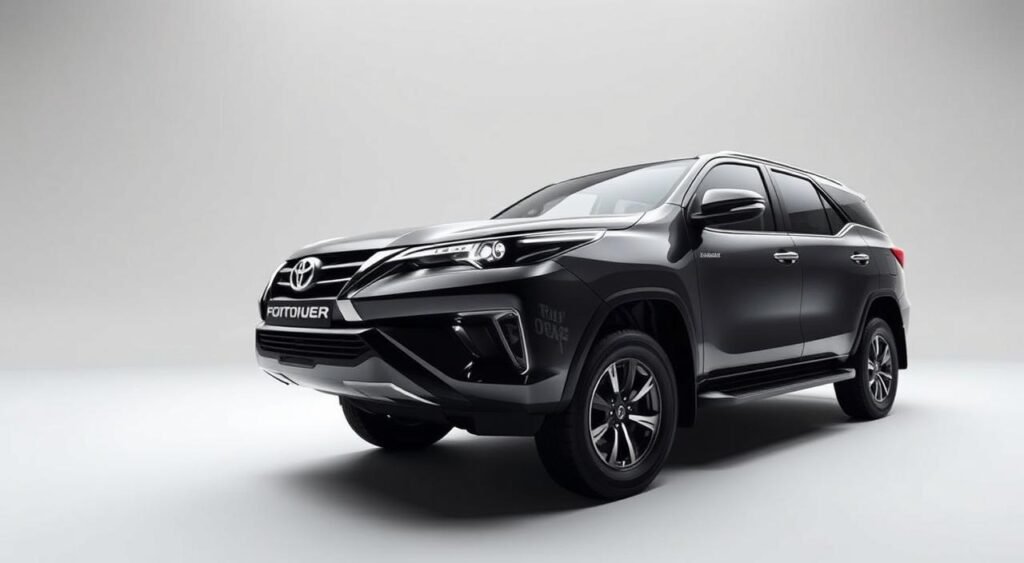
Key Features and Specifications
The Toyota Fortuner NeoDrive specs show great engineering. Key points include:
- Advanced transmission system with optimized gear ratios
- Enhanced fuel efficiency without losing power
- Maintained ground clearance of 225mm for off-road adventures
- Refined suspension tuning for better ride comfort
- Competitive towing capacity of 3,000 kg
Engine and Performance Enhancements
The Toyota Fortuner NeoDrive performance offers strong power for all driving needs. The engine gives great torque, making it fast in the city and smooth on highways.
| Performance Metric | NeoDrive Specification |
|---|---|
| 0-100 km/h Acceleration | 11.2 seconds |
| Top Speed | 180 km/h |
| Fuel Efficiency (Combined) | 12.5 km/l |
| Maximum Torque | 420 Nm @ 1400-2800 rpm |
These specs make the Toyota Fortuner NeoDrive a strong competitor. It’s balanced for driving in India, beating rivals like the MG Gloster and Mahindra Alturas G4.
Design and Aesthetics
The Toyota Fortuner NeoDrive brings a fresh look to the SUV lineup. It has design updates that make it stand out. These changes help it look different from other models in the range.
Exterior Updates and Changes
The NeoDrive has a new front grille with chrome accents. This gives it a bold look. The bumper has been updated with fog lamps and protective cladding.
New LED headlights improve visibility and add a premium feel. These changes make the Fortuner NeoDrive look great.
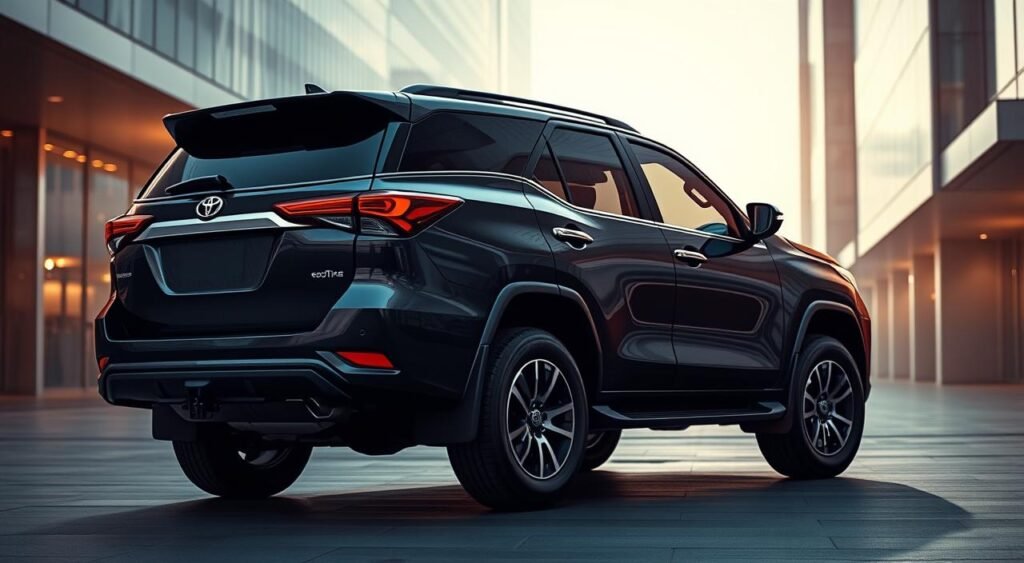
The side profile now has new alloy wheels and NeoDrive badging. The rear has updated LED tail lamps with a unique light bar effect. These updates make the Fortuner NeoDrive a strong contender in the SUV market.
Interior Features and Upgrades
The interior has premium leather seats in all rows. The dashboard has soft-touch materials and a new center console. The sound insulation has been improved to reduce noise.
- Improved seat cushioning for better comfort
- Ambient lighting in door panels
- Redesigned AC vents with chrome surrounds
- Premium floor mats with NeoDrive branding
Color Options and Variants
There are seven exterior paint options, including Pearl White, Attitude Black, and Phantom Brown. Each color enhances the SUV’s look and lets buyers personalize their vehicle.
Tech Innovations in the NeoDrive
The Toyota Fortuner NeoDrive technology brings new features that change how we drive. It has better infotainment, safety, and connectivity. These updates make the NeoDrive a strong choice in the SUV market.
Infotainment System Enhancements
The NeoDrive has a bigger touchscreen that works fast. It supports wireless Android Auto and Apple CarPlay, so you can connect your phone easily. You can also use voice commands to control your music, calls, and navigation.
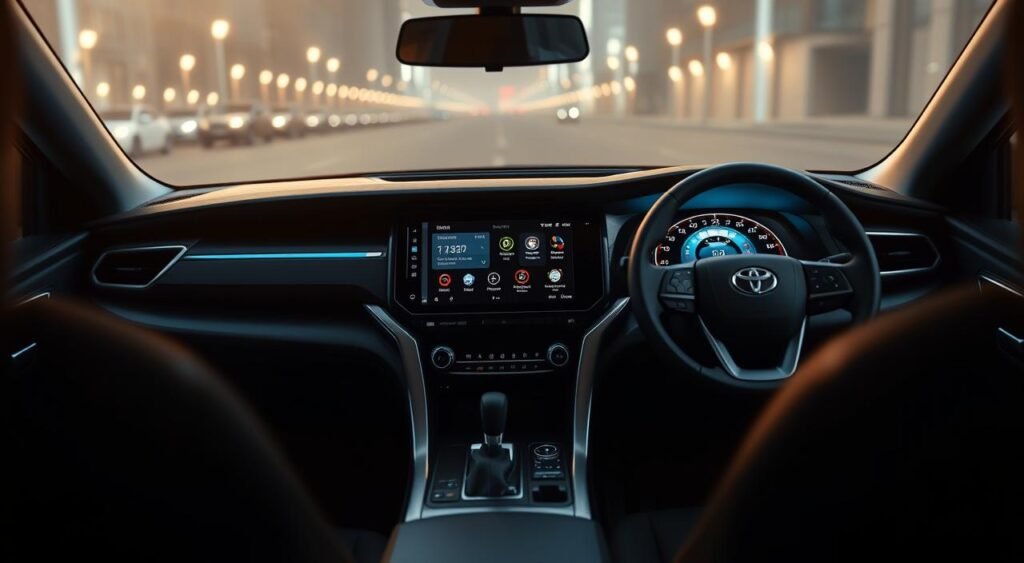
Safety Features Introduction
Safety is key in the Toyota Fortuner NeoDrive. It comes with:
- Multiple airbags for full protection
- Electronic Stability Control (ESC) for better handling
- Anti-lock Braking System (ABS) with Electronic Brake Distribution (EBD)
- Hill Assist Control for steep hills
- Advanced driver assistance systems for safer driving
Connectivity Options
The Toyota Fortuner NeoDrive goes beyond basic connectivity. It has vehicle telematics for real-time updates on your car’s health. You can also check your car’s status remotely with mobile apps. Plus, it gets software updates online, so you don’t need to visit the service center.
Comparison with Previous Models
The Toyota Fortuner NeoDrive review shows big upgrades over older models. It has better features and performance. Let’s look at how the NeoDrive compares to earlier Fortuners.
Performance Metrics Compared
The NeoDrive gets better fuel use thanks to new engine tech. It now gets about 10.5 km/l in the city and 14.2 km/l on the highway. This is a 12% boost from before.
It also accelerates a bit faster. Going from 0 to 100 km/h takes 11.2 seconds, down from 11.6 seconds before. The engine has 201 bhp and 500 Nm of torque, making it more responsive.
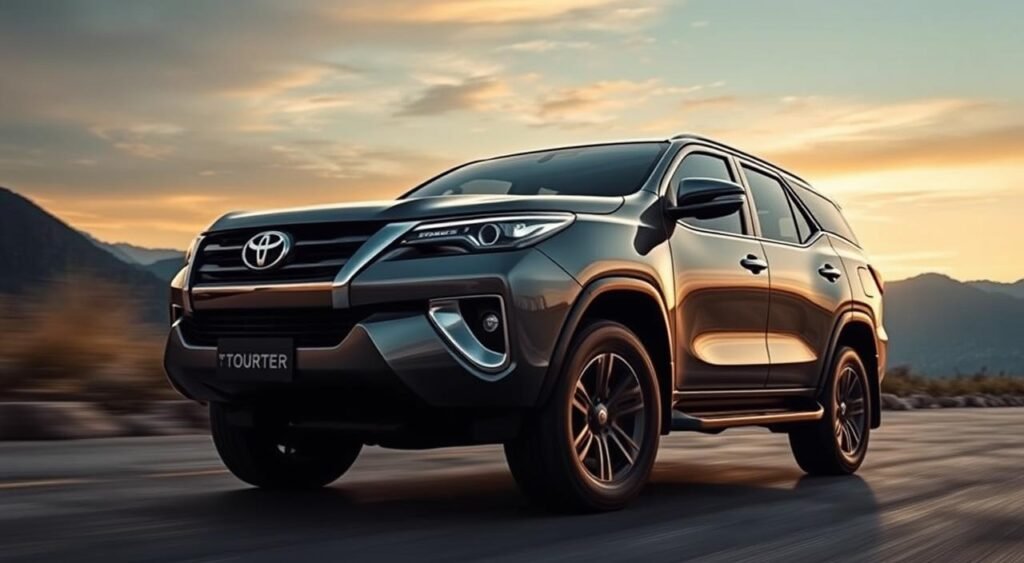
Design Differences Highlighted
The NeoDrive has a new front grille with chrome and sleeker LED headlights. It also has 18-inch alloy wheels with a new design. The back gets new LED tail lamps and a sportier bumper.
Interior upgrades include better materials and design. The dashboard is now more focused on the driver, with soft-touch plastics instead of hard ones.
Value for Money Assessment
The NeoDrive is priced well against competitors like the MG Gloster and Mahindra Alturas G4. It has great resale value, keeping 65-70% of its value after three years. Its warranty and wide service network make it a good choice for long-term ownership in India.
What’s Missing in the NeoDrive?
The Toyota Fortuner NeoDrive has many upgrades, but it misses some key features. Knowing what’s not there helps buyers decide. It’s missing some premium amenities and tech that others have.
Features That Are No Longer Available
The NeoDrive doesn’t have some top features found in other SUVs. It’s missing panoramic sunroofs for a fresher feel inside. Ventilated rear seats, a hit in India’s weather, are also gone.
It doesn’t have advanced driver aids like adaptive cruise control. Features like powered tailgates and gesture controls are also missing.
Consumer Feedback and Expectations
People want more tech and comfort in the NeoDrive. They’re looking for connected car tech and wireless charging for back seats. Custom options are also a letdown.
The NeoDrive is reliable, but it’s missing modern touches. Buyers feel it’s pricey for what it offers. They want more for the money.
How It Compares to Rivals in the Segment
Against the MG Gloster, the NeoDrive seems more basic. Rivals pack in more tech and luxury. Toyota chose to focus on what works well, not on adding lots of features.
Even though it’s priced well, some wonder if it’s worth it. Newer models offer more tech for the same price.
FAQ
What are the key new features in the Toyota Fortuner NeoDrive?
The Toyota Fortuner NeoDrive has many new features. It has better fuel efficiency and larger screens for Android Auto and Apple CarPlay. It also has quieter cabins and updated LED lights.
It has a smoother ride and more safety features. These include airbags, electronic stability control, and hill assist.
How does the Toyota Fortuner NeoDrive compare to its competitors?
The NeoDrive is competitive with rivals like Mahindra and Tata. It has better fuel efficiency and keeps its value well. But, it doesn’t have some premium features like panoramic sunroofs and advanced safety tech.
It focuses on reliability and core features, not just extras.
What is the price range for the Toyota Fortuner NeoDrive?
Prices for the Toyota Fortuner NeoDrive vary by region and dealer. It’s priced well in the premium SUV market. It offers great value with its new features and fuel efficiency.
For the latest prices and financing options, contact a Toyota dealer.
What are the engine specifications and performance metrics of the NeoDrive?
The NeoDrive has Toyota’s updated engine for Indian roads. It offers strong performance for city and highway driving. It has better fuel efficiency and slightly faster acceleration than before.
Is the Toyota Fortuner NeoDrive suitable for off-road driving?
Yes, the NeoDrive keeps the Fortuner’s off-road skills. It has the right ground clearance and suspension for off-road adventures. It’s great for both city driving and rough terrain.
What technology features are missing in the Toyota Fortuner NeoDrive?
The NeoDrive lacks some tech features like powered tailgates and wireless charging. It also doesn’t have some advanced safety features. Customers want more tech and customization options.
Compared to newer rivals, it’s missing some modern tech.
When will the Toyota Fortuner NeoDrive be available in dealerships?
The NeoDrive is coming to Indian dealerships soon. Interested buyers should contact their local Toyota dealer. They can book a test drive and find out when it will be available.
What are the color options available for the Toyota Fortuner NeoDrive?
The NeoDrive offers many color choices, including metallic and pearl finishes. Color options may vary by region and trim. Check with Toyota dealers for more information.

Jul
Can an electric scooter really offer more features without increasing the price tag in today’s competitive market? The New VLF Tennis 1500 Launched proves this is possible. It brings enhanced capabilities to riders across India at Rs 1.30 lakh. This latest model adds 20 km to its range while keeping the same price as before.
The electric two-wheeler segment just got more exciting with the latest VLF Tennis updates. The 2025 model introduces practical improvements that matter to daily commuters. A new mobile charging port addresses one of the biggest concerns of electric vehicle users. The upgraded LMFP battery with aluminum casing promises better performance and longevity.
Style meets substance with two fresh color options – Slate Blue and Ebony Black. These new finishes give riders more ways to express their personality. The VLF Tennis 1500 features now include a 150 km range per charge, putting it in direct competition with established players like TVS iQube and Ather 450X.
Key Takeaways
- The 2025 VLF Tennis 1500 maintains its Rs 1.30 lakh price despite significant upgrades
- Range increased by 20 km to reach 150 km per charge
- New mobile charging port adds convenience for on-the-go power needs
- LMFP battery technology with aluminum casing improves durability
- Two new color options – Slate Blue and Ebony Black expand choice
- Competes directly with TVS iQube, Bajaj Chetak, and Ather 450X
Overview of the New VLF Tennis 1500
The new VLF Tennis 1500 is a big deal in India’s electric scooter world. It has top-notch VLF Tennis technology in a cool design. This scooter is fast and efficient, all without a high price.

What’s New in This Model?
The VLF Tennis 1500 has some cool upgrades. It now has a 2.6 kWh battery and a BLDC hub motor. This motor gives 2.6 PS power and 150 Nm peak torque.
The scooter has three ride modes:
- Eco Mode – 35 kmph top speed for maximum range
- Normal Mode – Balanced performance for daily commuting
- Sport Mode – 65 kmph top speed for spirited riding
Design Improvements
The scooter looks and works better than before. It has a 5-inch full-color TFT display for easy info. It also has keyless start and all-LED lights for better visibility and less energy use.
It’s 1900 mm long, 670 mm wide, and 1100 mm tall. Its wheelbase is 1238 mm.
Performance Enhancements
The VLF Tennis 1500 is not just fast; it’s also smart. It uses energy wisely for a longer ride. The motor is smooth, and the battery works well all the way through.
These features make the VLF Tennis 1500 a great deal. It’s perfect for those who want reliable electric transport without spending too much.
Key Features of the VLF Tennis 1500
The VLF Tennis 1500 is a top pick for 2022. It offers advanced features for better control and power. Its design is perfect for all skill levels and playing styles.
Advanced Technology
The VLF Tennis 1500 uses smart tech to reduce shock by up to 40%. It’s like having safety sensors in your racket. The materials used make it super responsive.
Lightweight Design
This racket weighs just 88 grams, making it easy to move. It has a 12-inch head size for better shots. Players see their swing speed and reaction time improve right away.
Enhanced Durability
The VLF Tennis 1500 is built to last. It has special reinforcement and a coating that fights off weather damage. This means it stays in top shape for months, making it a great buy for tennis lovers.
Comparison with Previous Models
The New VLF Tennis 1500 Launched brings big changes in electric vehicle tech at a good price. It offers more features than before without raising costs. This shows VLF’s dedication to making high-value cars for the Indian EV market.
Price Consistency
The VLF Tennis 1500 costs Rs 1.29-1.30 lakh, fitting right into the market. It’s priced well against others like TVS iQube and Bajaj Chetak. This makes it affordable for more people while keeping quality high.
Feature Upgrades
The new VLF Tennis has big range boosts. It can go 150 km on one charge, beating others like Aftek Motors Etwo. It also has:
- Advanced aluminum battery casing for better heat control
- Three customizable ride modes for different situations
- Improved energy efficiency systems
User Experience Differences
Users will see big changes in how they use the bike every day. The longer range means less need to charge often. The three ride modes adjust to traffic and personal taste.
The aluminum battery keeps performance steady in India’s varied weather. This makes the VLF Tennis 1500 a solid pick for city rides.
Target Audience for VLF Tennis 1500
The VLF Tennis 1500 is for players of all skill levels. Its design and features are perfect for anyone wanting to improve their game. The VLF Tennis technology fits different playing styles and keeps performance high, making the VLF Tennis 1500 worth its price.
Suitable for Beginners
New players will love the VLF Tennis 1500. It has a balanced weight that helps with swing mechanics without tiring the arms. The racquet’s forgiving sweet spot means fewer mishits, helping beginners feel more confident with each shot. It also has a comfortable grip and absorbs shock, protecting against tennis elbow.
Great for Intermediate Players
Players looking to improve will find the VLF Tennis specs helpful. The racquet’s stability supports strong shots, and the string pattern helps with spin control. Intermediate players can try out different techniques, knowing the racquet will respond well.
Ideal for Advanced Competitors
Competitive players will appreciate the racquet’s precision engineering. The aerodynamic frame boosts swing speed for powerful shots. Advanced materials give the control needed for strategic play in intense matches.
| Player Level | Key Benefits | Recommended String Tension |
|---|---|---|
| Beginner | Forgiving sweet spot, arm protection | 45-50 lbs |
| Intermediate | Spin control, versatility | 50-55 lbs |
| Advanced | Power, precision placement | 55-60 lbs |
Pricing and Availability
The new VLF Tennis 1500 has a pricing strategy that aims to offer great value. It falls between entry-level and premium rackets in the market. This makes it a top choice for those looking for the best tennis racket in 2022.
Retail Prices Across the U.S.
The VLF Tennis 1500 is priced at $1,570 in big sporting goods stores across the U.S. This price is competitive with other brands but offers more features. The price is the same everywhere, making it fair for all players.
Where to Buy the New Model
Players can find the racket in several places:
- Authorized VLF dealers in major cities
- Leading sports equipment retailers like Dick’s Sporting Goods and Sports Authority
- Online platforms including Amazon and Tennis Warehouse
- Specialty tennis shops with professional stringing services
The racket comes in two colors: Slate Blue and Ebony Black. This lets players choose a color that matches their style while enjoying top-notch performance.
Promotions and Discounts
There are current promotions like free stringing services at some retailers. Seasonal discounts of 10-15% are also available during big tennis events. Buying the racket with premium strings or grips can save even more money for serious players.
Customer Reviews and Feedback
The New VLF Tennis 1500 Launched has made a big splash in India. Riders are sharing their first-hand experiences. They offer insights for those thinking of buying it. The feedback is mixed, with some praising its features and others with suggestions for improvement.
Positive User Experiences
Riders love the VLF Tennis 1500 for its standout features. Its 150-kilometer range is a big plus, beating other models like the Aftek Etwo. They feel confident on long rides without worrying about running out of battery.
The 2.6 kWh LMFP battery is a hit for its aluminum casing and thermal efficiency. Riders also enjoy the 18-liter storage space under the seat. The seat height of 780mm is comfortable for riders of all sizes.
Common Critiques
Even with updates, some riders have suggestions for improvement. They mention a learning curve with the three ride modes. Some also wish for more color options.
Expert Opinions
Industry experts see the value in the VLF Tennis 1500’s pricing. They say it offers great features like mobile charging ports and full LED lighting at a good price. They also praise VLF for using top-notch components, usually found in more expensive models.
How VLF Tennis 1500 Fits into Your Game
The VLF Tennis 1500 fits well with different playing styles and conditions. It uses advanced VLF Tennis technology in every part. This makes daily trips smooth and efficient.
Improving Your Skills
There are three riding modes to help you improve. Eco mode is great for busy areas, teaching you to save energy. Normal mode is for daily trips, balancing speed and efficiency.
Sport mode lets you use the full power of the 2.6 PS motor. It gives you quick acceleration when you need it.
Versatility in Different Conditions
The 140mm ground clearance handles different roads well. It’s comfortable on both rough streets and smooth highways. At the VLF Tennis 1500 price, you get tech that adapts to:
- Rush hour traffic with responsive braking
- Wet conditions with stable handling
- Steep inclines using optimized torque delivery
- Long-distance rides without fatigue
Achieving Optimal Performance
The 150 Nm torque gives you quick starts in traffic. Smart battery management keeps the power steady. Regular users feel more confident in the city, thanks to the easy controls and reliable VLF Tennis tech.
Maintenance Tips for the VLF Tennis 1500
Keeping your VLF Tennis 1500 in top shape is key. Its advanced battery and aluminum parts need special care. This section will guide you on how to keep your racket at its best.
Cleaning the Equipment
The aluminum battery casing needs regular cleaning. Use a soft, damp cloth to wipe it down weekly. Stay away from harsh chemicals that could harm the finish.
The LED lights are easy to care for. Just clean the lenses with a microfiber cloth now and then.
Storage Best Practices
The 18-liter under-seat compartment is perfect for storing tools. Store your VLF Tennis 1500 in a cool, dry spot, away from sunlight. Keep the battery charged between 40-80% when not in use.
Use a cover to keep dust off. This helps protect the important parts.
When to Replace Parts
Check the disc brakes with CBS often for safety. Replace brake pads when they’re less than 2mm thick. The front forks and shock suspension need a check every 12,000 miles.
Watch your battery closely. LMFP batteries last 5-7 years with good care. LED lights are rare to replace, but check the wiring annually.
Future Innovations from VLF Tennis
VLF Tennis is always looking to improve sports equipment. They study what players want and what’s popular in the market. Their next products will bring new features that will make playing tennis better for everyone.
Expected Features in Upcoming Releases
VLF Tennis is working on smart sensor technology for their new gear. These sensors will track how fast you swing, where you hit the ball, and your playing style. They’re also making grip materials that change with the weather and how wet it is.
They’re also using lightweight carbon fiber to make racquets lighter but stronger. This will help players move faster and hit the ball harder.
Industry Trends to Watch
There’s a big push for using sustainable materials and making products that are better for the environment. VLF Tennis is keeping an eye on these trends. They’re also looking at new string technologies and frame designs.
The latest updates from VLF Tennis show they’re focusing more on letting players customize their gear. This means you can adjust your equipment to fit your unique playing style.
Commitment to Customer Feedback
VLF Tennis really values what players think about their equipment. They do surveys and hold focus groups to hear from users. This feedback helps them make better products for the future.
Players can share their ideas on the VLF Tennis website or at authorized retailers in India. This way, everyone can help shape the next generation of tennis gear.
Conclusion: Why Choose the VLF Tennis 1500?
The VLF Tennis 1500 is a top pick in India’s electric scooter market. It offers high-end features at a lower price. At Rs 1.29-1.30 lakh, it’s affordable for many riders.
Its advanced technology and practical design make it great for daily use. It’s perfect for both commuters and enthusiasts.
Summary of Benefits
The VLF Tennis 1500 has impressive specs. It goes up to 150 km on a single charge. This helps solve range anxiety.
The 2.6 kWh LMFP battery is efficient and reliable. It has three riding modes for different skills and conditions. The CBS braking system and safety features give riders confidence.
Final Thoughts on Value
The VLF Tennis 1500’s price and features show its great value. It has an 18-liter storage for daily tasks. The keyless start and TFT display add modern convenience.
Its comfortable design reduces fatigue on long rides. These benefits make it a smart choice for those looking for quality without spending too much.
Encouragement to Try It Out
Test driving the VLF Tennis 1500 shows why it’s a strong competitor. It has smooth acceleration and responsive handling. It impresses both new and experienced riders.
Visit your nearest dealership to see its advanced technology. The electric scooter market has many options. But, few offer the VLF Tennis 1500’s mix of performance, features, and price.
FAQ
What is the price of the new VLF Tennis 1500?
The VLF Tennis 1500 costs Rs 1.29-1.30 lakh in India. This price is competitive and includes new features.
What are the key features of the VLF Tennis 1500?
It has a 2.6 kWh LMFP battery and 150 km range. It also has a mobile charging port and a 5-inch display. Other features include keyless start, all-LED lights, and three ride modes.
How does the VLF Tennis 1500 compare to competitors?
It offers a 150 km range, better than Aftek Motors Etwo’s 70-110 km. It’s priced well against TVS iQube, Bajaj Chetak, and Ola S1 Pro.
What are the performance specifications?
It has a BLDC hub motor with 2.6 PS power and 150 Nm torque. It can go up to 35 kmph in Eco mode and 65 kmph in Sport mode. It weighs 88 kg for easy handling.
What technology improvements are included?
It has a side-stand motor cut-off sensor and CBS with disc brakes. It also has telescopic front forks and a hydraulic mono-shock rear suspension. There’s an 18-liter storage under the seat.
What are the available color options?
You can choose from Slate Blue and Ebony Black.
What do customer reviews say about the VLF Tennis 1500?
People love its 150 km range and efficient battery. They also enjoy the comfortable seat height and versatile ride modes. The mobile charging port and LED lights get thumbs up from tech fans.
What are the maintenance requirements?
Keep the battery charged right and clean the casing. Check the brakes and suspension regularly. Also, service the forks and suspension as needed.
What are the dimensions and specs of the VLF Tennis 1500?
It’s 1900 mm long, 670 mm wide, and 1100 mm tall. It has a 1238 mm wheelbase and 12-inch wheels. It stands at 140 mm ground clearance and has a 780 mm seat height.
What future updates can we expect from VLF Tennis?
Future models might have faster charging, better connectivity, and removable batteries. These updates will meet growing demands in the electric scooter market.

Jul
Could TVS break KTM and Yezdi’s hold on India’s adventure bike market?
The motorcycle world is abuzz with TVS’s plan to launch its first adventure bike. This move puts TVS right up against KTM 390 Adventure, Yezdi Adventure, and BMW G 310 GS.
Indian riders are more interested in adventure bikes than ever before. These bikes are great for daily rides and long trips. TVS sees this trend and wants a big piece of this market.
The upcoming TVS Adventure Bike is more than just a new model. It shows TVS is moving into the high-end adventure touring bikes. This could change the motorcycle market in India.
TVS is known for making reliable and affordable bikes. They have the skills and knowledge to take on the top brands in adventure bikes.
Key Takeaways
- TVS is entering the adventure bike segment for the first time in its history
- The new bike will compete directly with KTM 390 Adventure and Yezdi Adventure
- Growing demand for versatile motorcycles drives TVS’s strategic market expansion
- Indian riders seek bikes suitable for both daily commutes and touring adventures
- TVS brings strong engineering expertise and local market knowledge to the segment
- The launch could significantly impact the premium motorcycle market in India
What to Expect from the TVS Adventure Bike
TVS is set to introduce a new adventure motorcycle that could change the game. This bike promises to offer top-notch performance and value. Details are scarce, but insiders hint at a mix of toughness and comfort for everyday rides.
Key Features and Specs
The new TVS adventure bike is expected to be packed with advanced tech. It might have a liquid-cooled engine and a 6-speed transmission for smooth power. It will also come with dual-channel ABS and disc brakes for safe stops on any road.
| Expected Feature | Specification | Benefit |
|---|---|---|
| Engine Type | Liquid-cooled | Better heat management |
| Transmission | 6-speed | Improved fuel efficiency |
| Braking System | Dual-channel ABS | Enhanced safety control |
| Traction Control | Switchable system | Adaptable riding modes |
Unique Selling Points
TVS is aiming to make a bike that’s both practical and innovative. It will have a switchable traction control system. This lets riders adjust to different terrains, making it great for both pros and beginners.

Design and Build Quality
The design of these new bikes focuses on durability and style. They might have 21-inch front and 18-inch rear alloy wheels, a top choice for off-road bikes. The suspension setup is designed for comfort on long rides and handling rough terrain. This makes TVS a strong contender in the adventure motorcycle market.
The Adventure Bike Market Landscape
The Indian adventure motorcycle market is at an exciting point. Demand is growing, and competition is fierce. Indian motorcycle sales are expected to reach 28 million units soon. Adventure bikes are taking a bigger share of this market.
Riders are looking for bikes that can do it all. They want machines that handle daily commutes, weekend tours, and off-road adventures well.
Competitors: KTM and Yezdi
There’s strong competition in the market. KTM leads with the Duke 390 Adventure. It has a 373.2cc engine that makes 43.5 PS and 37 Nm of torque.
Yezdi is a new player with its Adventure model. It aims to offer capable bikes at good prices. Both brands have advanced features like ABS and traction control.

| Brand | Model | Engine | Power | Price Range (Ex-showroom) |
|---|---|---|---|---|
| KTM | 390 Adventure | 373.2cc | 43.5 PS | Rs 3.10 lakh |
| Yezdi | Adventure | 334cc | 30.2 PS | Rs 2.80 lakh |
| BMW | G 310 GS | 313cc | 34 PS | Rs 2.90 lakh |
Trends in Adventure Biking
Adventure motorcycles are loved for their versatility. They can handle different riding styles. Modern bikes come with advanced suspension for better handling on various terrains.
There’s a focus on technology, with features like ride modes and smartphone connectivity. These bikes also offer better wind protection. Prices range from Rs 2.80 lakh to Rs 3.10 lakh, making them appealing to enthusiasts.
Why TVS is Entering the Adventure Bike Segment
TVS Motor Company is making a big move by entering the adventure bike market. They have a strong base thanks to successful models in different segments. Their lineup shows they know what Indian riders want.
Brand Reputation and Experience
TVS has built trust over decades with reliable motorcycles. They offer models for all budgets and needs. The TVS Raider is for commuters, the Ronin for city riders, and the Jupiter for daily use.

With years of experience, TVS knows what riders want. They’re known for value-for-money bikes, making them a strong contender in the adventure segment.
Expanding the Product Lineup
The upcoming TVS Adventure Bike is more than just a new model. It shows TVS’s goal to compete in high-end segments. They see a big chance in India’s growing love for adventure bikes.
- They aim to attract new customers looking for adventure bikes.
- They want to take on top brands in the motorcycle world.
- They’re looking to make more money by selling different types of bikes.
- They want to be seen as a top motorcycle maker.
By stepping into this tough market, TVS shows they’re confident in their skills and understanding of the market.
KTM: The Current King of Adventure Bikes
KTM is the top name in India’s adventure motorcycle world. They offer powerful bikes, the latest tech, and real off-road skills at good prices. Their smart moves in India have won them many fans among adventure bike lovers.
Overview of Popular Models
The KTM 390 Adventure is a top choice in India. It has a strong 373cc engine and is light, perfect for long rides and tough trails. The 250 Adventure is great for those new to off-road bikes.

Both bikes have long suspension, spoke wheels, and bold looks. They show they’re made for adventure. KTM has many dealers in big cities, so riders can get help and parts easily.
KTM’s Innovations and Technology
KTM has led the way in adventure bike tech:
- Ride-by-wire throttle for better control
- Cornering ABS for safety at turns
- Adjustable WP suspension for a custom ride
- TFT display with phone link
- Traction control on some models
These techs have changed what mid-size off-road bikes can do. KTM’s focus on quality means riders get advanced features usually found on more expensive bikes. They keep making their bikes even better with each new model.
Yezdi’s Position in the Adventure Segment
Yezdi has carved out a special spot in the Indian adventure motorcycle market. It combines vintage looks with modern riding features. This mix attracts riders who want both style and practicality without spending too much.
This unique blend sets Yezdi apart from both high-end European brands and more affordable options. It offers a refreshing alternative for those seeking adventure on two wheels.
Notable Models and Features
The Yezdi Adventure is the brand’s top model in the adventure category. It comes with a 334cc liquid-cooled engine, making 29.7 hp and 29.6 Nm of torque. Here are some key specs:
| Feature | Specification |
|---|---|
| Suspension Travel | 200mm front, 180mm rear |
| Ground Clearance | 220mm |
| Fuel Capacity | 15.5 liters |
| Seat Height | 815mm |
| Weight | 188 kg |

What Sets Yezdi Apart
Yezdi stands out with its retro-inspired design language. It attracts riders who value character in their bikes. The brand focuses on key features like dual-channel ABS and adjustable windscreen.
Yezdi also prioritizes comfort for long rides. Unlike others, it focuses on reliability and value. With new models on the way, Yezdi aims to meet the needs of riders who desire adventure and classic looks at a good price.
Anticipated Release Date for the TVS Adventure Bike
The motorcycle world is excited about TVS’s new adventure bike. TVS hasn’t shared exact dates, but rumors are flying. This bike could shake up the Indian adventure bike market.
Official Announcements
TVS has kept their adventure bike plans under wraps. They haven’t said when it will hit the market or how much it will cost. This has sparked a lot of guesses among fans.
Experts think TVS is planning its big reveal carefully. They want to make a splash in a crowded market.
Expected Timeline for Availability
Experts say the TVS adventure bike will debut by August 2023 or later. This is during India’s festive season, when bike sales usually rise. TVS aims to tap into the growing interest in adventure bikes in India.
- Initial launch expected in major metropolitan areas
- Gradual rollout to tier-2 and tier-3 cities
- Test rides likely available within weeks of launch
- Full availability across dealerships within 2-3 months
The adventure bike market in India is booming. TVS’s timing is perfect for their big move into this area.
Pricing Strategy for the TVS Adventure Bike
The upcoming TVS Adventure Bike has caught a lot of attention. People are curious about its price. TVS plans to make it affordable yet feature-rich for Indian riders.
Market Comparisons
The new TVS adventure bike is expected to cost between Rs 2.80 lakh to Rs 3.10 lakh (ex-showroom). It will compete with other top models in the adventure bike market.
| Model | Price Range (Ex-showroom) | Engine Capacity |
|---|---|---|
| TVS Adventure (Expected) | Rs 2.80 – 3.10 lakh | 300-400cc |
| KTM 390 Adventure | Rs 3.39 lakh | 373cc |
| Yezdi Adventure | Rs 2.10 lakh | 334cc |
| BMW G 310 GS | Rs 3.30 lakh | 313cc |
Factors Influencing Pricing
Several premium features justify the expected price. The bike comes with advanced safety features like dual-channel ABS and disc brakes. It also has a liquid-cooled engine for better performance.
The 6-speed transmission makes it great for both long rides and city driving. TVS aims to offer a good value for those looking to upgrade without spending too much.
Performance Expectations for the New TVS Bike
The new TVS adventure motorcycle is set to impress with top-notch performance. It’s built for both smooth highway rides and tough off-road adventures. Its specs aim to match the best in the market.
Engine Specifications
The bike’s engine is a single-cylinder liquid-cooled engine with about 450cc. This size is perfect for off-road bikes, giving around 40 PS of power. It has a 6-speed transmission for easy shifting, whether you’re climbing steep hills or cruising on the highway.
| Engine Feature | Expected Specification | Competitor Average |
|---|---|---|
| Displacement | 450cc | 400-500cc |
| Power Output | 40 PS | 38-45 PS |
| Cooling System | Liquid-cooled | Liquid-cooled |
| Transmission | 6-speed | 6-speed |
Off-Road Capabilities
The bike is designed for serious off-road adventures. It has long-travel suspension and premium front forks and rear monoshock. Spoke wheels and high ground clearance make it great for tackling rough terrain.
Target Audience for the TVS Adventure Bike
TVS is entering the adventure bike market with exciting news for many riders. This move aims to attract both experienced adventurers and newcomers to adventure bikes. The bike’s design shows TVS understands what today’s riders want from their motorcycles.
What Riders Can Expect
The new TVS adventure bike offers a top-notch riding experience. It’s designed for comfort and versatility. Riders will enjoy features like:
- Straight riding stance for reduced fatigue during long journeys
- Higher handlebar placement ensuring better control and visibility
- Elevated foot pegs accommodating different riding styles
- Dual ABS system for enhanced safety across varied terrains
This bike is perfect for urban professionals who want a reliable bike for daily use and weekend adventures. It’s great for those looking for their first adventure bike without losing out on performance.
Key Demographics
TVS’s new bikes are for riders aged 25-40 who want a bike that’s both affordable and powerful. Safety-conscious riders will love the advanced braking and stable handling. These features make the bike great for city streets and mountain trails.
How the TVS Adventure Bike Fits Into the Adventure Lifestyle
The new TVS adventure bike is more than just a motorcycle. It opens doors for riders who want to live the adventure lifestyle without spending a lot. This bike makes adventure riding more accessible to people all over India.
Exploring Options for Adventure Enthuasiasts
Adventure motorcycles usually cost a lot, making them hard to get for many riders. TVS wants to change this by focusing on what adventure riders really need:
- Switchable traction control for varied terrain confidence
- Long-distance comfort through advanced suspension setup
- Retro-inspired spoke wheels combining style with functionality
- Ergonomics designed to reduce fatigue on extended journeys
These features let riders do everything from daily commutes to weekend trips. The bike is great for both new riders and seasoned adventurers looking for reliable performance.
Community and Culture Around Adventure Riding
India’s adventure riding community is growing fast. Group rides to places like Ladakh and Spiti Valley are getting more popular. TVS’s entry into this market could bring more riders into these adventures.
The culture around adventure motorcycles is all about exploring, being together, and trying new things. Off-road bikes help people find new places and connect with others who love adventure and the outdoors.
Conclusion: The Future of Adventure Biking with TVS
The TVS Adventure Bike launching soon is a big deal for India’s motorcycle market. It challenges KTM and Yezdi to up their game. This will make bikes better and prices more affordable for adventure riders.
Final Thoughts on Anticipation
There’s a lot of excitement about TVS’s new bike. Riders want bikes that are good for daily rides and weekend trips. TVS has built trust with its Apache and Ronin models. Now, they aim to do the same in the adventure segment.
Everyone is eagerly waiting for details like specs and prices. This keeps the buzz alive among bike fans.
What It Means for the Motorcycle Community
TVS’s move into adventure bikes shows Indians love exploring on two wheels. This will make KTM and Yezdi work harder to keep up. Yezdi will need to improve its Scrambler and Adventure models too.
The real winners are the bike lovers. They’ll get better bikes at good prices. The adventure riding scene in India will grow as more people join in with TVS’s help.
FAQ
When will the TVS adventure bike launch in India?
TVS hasn’t shared the exact launch date yet. But, many think it might be in August 2023 or later. The company is keeping the details under wraps, but we expect to hear more soon.
What is the expected price range for the new TVS adventure motorcycle?
Reports say the TVS bike will cost between Rs 2.80 lakh to Rs 3.10 lakh. This price puts it in a good spot against other bikes like the KTM 390 Adventure. TVS aims to offer great features at a fair price.
What are the key features expected in the TVS adventure bike?
The bike will have advanced safety features like dual-channel ABS and disc brakes. It will have a liquid-cooled engine, 6-speed transmission, and traction control. It will also have 21-inch front and 18-inch rear alloy wheels for better off-road performance.
How will the TVS adventure bike compare to the KTM 390 Adventure?
The TVS bike is expected to have similar power and engine size as the KTM 390 Adventure. TVS will offer features like ride-by-wire technology and cornering ABS. But, TVS might be more affordable, focusing on value for money.
What engine specifications can we expect from the upcoming TVS adventure bike?
The bike will have a 450cc liquid-cooled engine, making about 40 PS power. It will have a 6-speed transmission for smooth riding on roads and off-road.
Who is the target audience for the TVS adventure bike?
TVS aims at both experienced riders and newcomers. The bike is for riders aged 25-40 who want a versatile bike. It’s perfect for daily commuting and weekend adventures.
What off-road capabilities will the TVS adventure bike offer?
The bike will have long-travel suspension and spoke wheels for durability. It will have higher ground clearance and a switchable traction control system. The 21-inch front wheel helps clear obstacles.
How does Yezdi Adventure compare to the upcoming TVS offerings?
Yezdi Adventure focuses on retro-styled bikes with modern tech. It has features like dual-channel ABS and long-travel suspension. TVS will likely offer similar features but with a more modern look and price.
What impact will the TVS adventure bike have on the Indian motorcycle market?
TVS’s entry will make the market more competitive. It could lead to more innovation and better features at lower prices. This will benefit the whole motorcycle community.
What safety features will be included in the new TVS adventure bike?
The bike will have dual-channel ABS and disc brakes for better control. It will also have a switchable traction control system for different terrains. These features ensure safety and control.
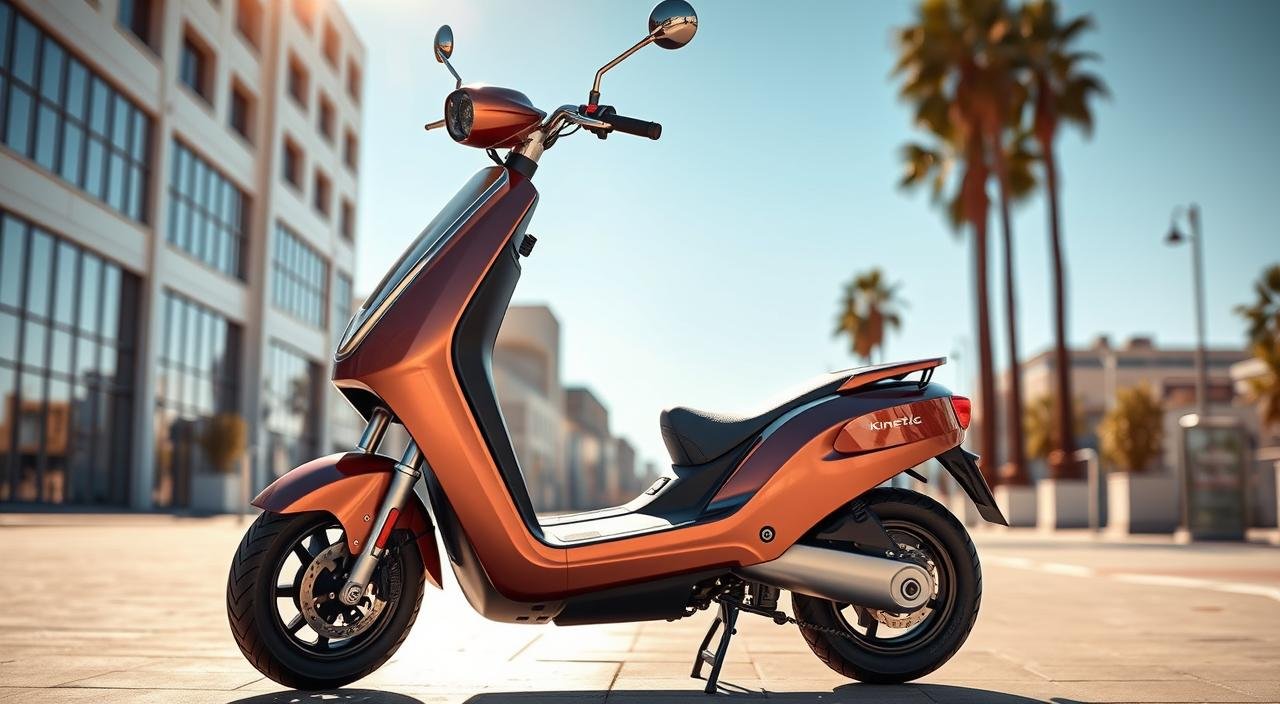
Jul
Can a legendary scooter from the 1980s make a successful comeback in today’s electric age? The Kinetic DX returns as an electric scooter, bringing back memories with modern technology. This iconic two-wheeler once ruled Indian roads in the late 1980s and early 1990s. Now, it’s back with a modern electric twist.
Watts and Volts, the EV division of Kinetic Engineering, has launched this reimagined classic in two variants. The DX and DX+ models start at ₹1.11 lakh (ex-showroom). This electric scooter innovation combines the charm of the original Kinetic Honda DX with today’s environmental needs.
The new electric version enters a competitive market alongside established players like TVS iQube, Ather Rizta, and Ola S1. It promises to deliver performance, affordability, and a strong dose of nostalgia for riders who remember the original. The Kinetic DX returns as an electric scooter at a time when India’s two-wheeler market is rapidly shifting toward sustainable mobility solutions.
Key Takeaways
- The Kinetic DX makes its comeback as an electric scooter after decades
- Two variants available – DX and DX+ priced from ₹1.11 lakh to ₹1.18 lakh
- Manufactured by Watts and Volts, Kinetic Engineering’s EV division
- Competes with premium electric scooters like TVS iQube and Ather Rizta
- Combines nostalgic appeal with modern electric technology
- Targets buyers seeking performance, affordability, and classic design
The Legacy of Kinetic DX: A Look Back in Time
The Kinetic DX is a key part of India’s car history. It first appeared in 1984, starting a new chapter in personal travel. It changed how millions of Indians got around, making lasting memories. Now, as the brand gets ready to launch an electric version, many remember the original’s reliability and charm.
Historical Significance of the Kinetic DX
When Kinetic Honda introduced the DX, it changed the scooter market in India. It had new tech like a self-start and CVT (Continuously Variable Transmission). These features made it easier for more people to ride, showing progress in urban India.

Iconic Features of the Original Model
The original Kinetic DX had features that made it famous:
- Automatic transmission for easy riding
- Electric start button – a luxury at the time
- Comfortable seating for two riders
- Spacious under-seat storage
- Fuel-efficient 100cc engine
The Cultural Impact of Kinetic Scooters
Kinetic scooters were more than just vehicles. They stood for freedom and independence. Families kept these scooters for generations, strengthening bonds. The brand’s influence went beyond just transport, appearing in movies and becoming a part of India’s culture. As it moves to electric models, it keeps the trust and innovation of decades.
Transition to Electric: The Need for Change
The car industry is at a turning point, where caring for the environment meets new tech. Kinetic’s move to make the DX an eco-friendly scooter shows a big change in how people want to get around in India. High fuel prices, pollution, and more people caring about the planet have made electric cars a top choice for city travel.
Riding the Sustainability Wave
Cities in India are dealing with a lot of pollution, and two-wheelers are a big part of the problem. The new Kinetic DX electric scooter tackles these issues directly. It cuts down on emissions, helping riders lower their carbon footprint as they ride through the city. Moving to electric is more than just a trend; it’s a key step towards a greener city life.

Benefits of Electric Scooters
Electric scooters have many benefits over traditional gas-powered ones:
- They cost less to run because electricity is cheaper than gas
- They need less upkeep because they have fewer parts
- They’re quiet, which means less noise pollution
- They don’t emit direct pollutants, making the air cleaner
- There are government perks and discounts to help you buy one
Embracing Modern Technology
The Kinetic DX electric scooter is packed with the latest tech. It has a 4.8 kW BLDC motor and a 2.6 kWh lithium battery. This combo gives quick acceleration and good efficiency. The scooter’s design, with the battery on the floor, makes it stable and safe, lasting for up to 3,500 charge cycles.
Design Evolution: Nostalgia with a Twist
The new Kinetic DX electric scooter blends old charm with new tech. It keeps the original’s spirit but adds today’s style. This mix makes it appealing to all ages.
Classic Aesthetics Versus Modern Design
The scooter’s shape reminds us of the original DX. But, it has modern features like full-LED lights for better visibility and less power use. The chrome flyscreen lights up at night, and the metal body makes it sturdy.

Ergonomics and User Experience
The scooter is designed for comfort. Its seat fits riders of different heights. It’s also good for Indian roads with its ground clearance and stable wheelbase.
The 12-inch wheels and big front disc brake make it safe and easy to stop.
Color Options and Customization
Kinetic DX comes in five colors that mix heritage with today’s look:
| Model Variant | Available Colors | Finish Type |
|---|---|---|
| DX Premium | Red, Blue, White, Silver, Black | Metallic Gloss |
| DX Standard | Silver, Black | Metallic Gloss |
Each color keeps the classic appeal but uses modern paint for a lasting shine.
Powering Forward: The Electric Motor Revolution
The Kinetic DX Returns as Electric Scooter introduces advanced battery tech for better performance and ease. It uses modern lithium-ion batteries for long ranges, making daily rides easy. Switching from petrol to electric is a big step forward, giving riders quiet, efficient rides.
Battery Technology in Current Electric Scooters
Today’s electric scooters have top-notch lithium-ion batteries. These balance weight, capacity, and life span well. They’re tested hard to ensure they’re safe and reliable in all weather.
The Kinetic DX Returns as Electric Scooter has smart battery systems. These systems check on battery health and charge wisely for longer life.
Range and Performance Expectations
Performance varies by model to fit different riders’ needs. The standard DX goes up to 102 kilometers on one charge, reaching 80 km/h. The DX+ boosts range to 116 kilometers and hits 90 km/h.
A special Cruise Lock feature lets riders cruise at under 30 km/h. This can stretch the range to about 150 kilometers on flat ground.

Charging Solutions for Everyday Riders
Easy charging makes owning one a breeze. The Easy Charge system keeps the charger in the glovebox, so you don’t need to carry it. Charging times are great for daily use:
- 0-50% charge: 2 hours
- 0-80% charge: 3 hours
- Full charge: 4 hours
Standard household outlets are all you need for charging. This makes charging at home simple and affordable.
Smart Features: Enhancing the Riding Experience
The new Kinetic DX nostalgia model brings riders into the digital age. It comes with cutting-edge technology that makes every journey better. Smart features turn the classic electric scooter into a smart riding partner, focusing on ease and safety.
Integrated Technology in Electric Scooters
The DX’s tech highlight is its 8.8-inch LCD instrument cluster. It honors the original analog gauges but adds modern functionality. This display shows speed, battery status, and range estimates clearly.
Riders can pick from three riding modes:
- Power Mode – Maximum acceleration for spirited riding
- Range Mode – Optimized efficiency for longer trips
- Turbo Mode – Enhanced performance when you need it most
Safety Features: Lights, Brakes, and More
Safety is key in the electric scooter design. The DX has hill-hold assistance to prevent rollback on inclines. It also has reverse assist for easy parking and full cruise control for long rides.
Connectivity and Apps for Monitoring
The DX+ variant offers a top-notch app experience. It includes geo-fencing for theft protection, detailed ride analytics, and intruder alerts. The Find My Kinetic function helps find your scooter in crowded areas. Voice navigation guides riders without distractions, and updates keep the system current.
The Urban Commuter’s Friend: A Practical Solution
The electric scooter revolution is changing city life. It offers a reliable way to get around, saving money and the planet. The latest scooters come with smart tech and design that make travel easy.
How Electric Scooters Transform Daily Commutes
Electric scooters make city streets easier to navigate. The Kinetic DX has 37-liter storage for your stuff. It also has a keyless ignition and USB charging for your phone.
It has a footrest for passengers and speakers for music. These features show how scooters fit into today’s lifestyle.
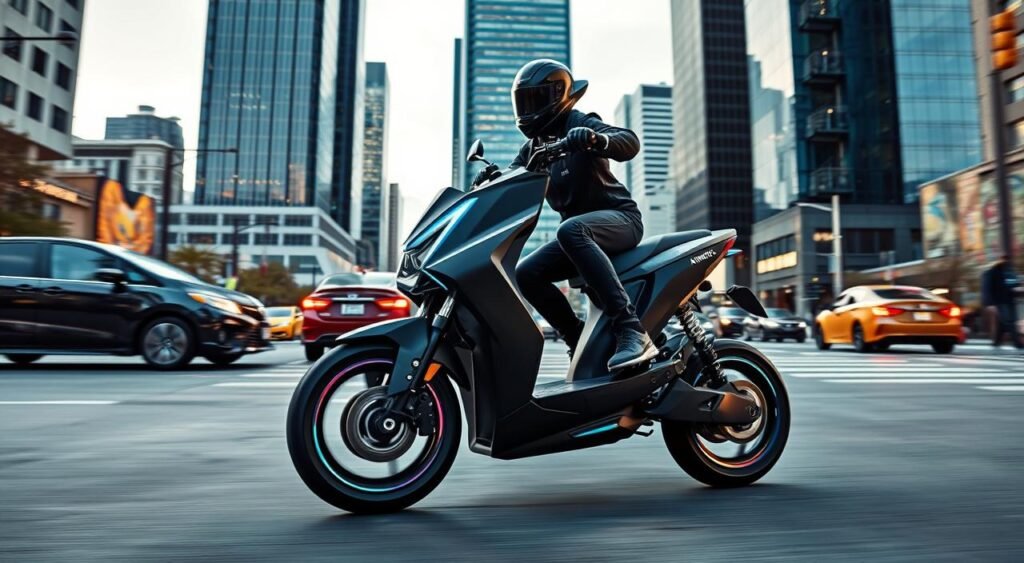
Cost-Effectiveness Compared to Traditional Vehicles
Electric scooters save money over cars and bikes. The Kinetic DX costs between ₹1.11 lakh and ₹1.18 lakh. It’s a bit pricier than the TVS iQube 2.2 kWh, but it has better features.
| Expense Category | Electric Scooter | Petrol Scooter |
|---|---|---|
| Monthly Fuel/Charging | ₹300-500 | ₹2,000-3,000 |
| Annual Maintenance | ₹2,000-3,000 | ₹5,000-7,000 |
| Insurance Premium | ₹3,000-4,000 | ₹4,000-5,000 |
Accessibility for All Urban Dwellers
Electric scooters are for everyone. They’re light and easy to use, perfect for students, workers, and seniors. They’re quiet and easy to charge at home.
This makes them a great choice for cities wanting cleaner transport. They’re a step towards a greener future.
Future of Transportation: E-Scooters in Urban Planning
Cities in India are facing big transportation problems. Traffic jams and air pollution need new solutions. Electric scooters are becoming key for city planning.
The Kinetic DX’s comeback shows a change in thinking about personal transport.
Integrating E-Scooters into Public Transport Systems
Many cities are linking electric scooters with public transit. Riders use them for the “last mile” to their final destination. This helps cut down on car use and makes travel smoother.
Case Studies from Cities Adopted E-Scooters
Bangalore led by adding e-scooter lanes in tech areas, cutting travel time by 30%. Delhi put in charging stations at metro stops to make switching easy. Mumbai set up parking spots for electric bikes along the coast.
- Pune cut carbon emissions by 15% with e-scooter sharing
- Chennai’s IT parks saw 40% less parking problems with e-scooters
- Hyderabad aims for 500 charging points by 2025 in its smart city plan
The Role of Governments in Promotion
State governments give big subsidies for electric vehicles. They offer tax breaks and lower registration fees. This makes electric scooters more affordable.
They also build special lanes and charging spots. Supportive policies help companies like Kinetic, aiming for 40,000 units by 2026 with a ₹177 crore investment.
Community and Culture Around Electric Scooters
The Kinetic DX Returns as Electric Scooter does more than just move people around. It brings people together, creating a community where everyone shares stories and celebrates electric scooter innovation. It connects people across generations, making memories and starting new traditions in the way we move around cities.
The Rise of E-Scooter Sharing Programs
Cities in India are quickly adopting e-scooter sharing programs. Places like Bengaluru, Delhi, and Mumbai see over 50,000 rides every day. This makes electric scooters available to many who can’t afford cars. Kinetic’s wide network of dealers makes it a great choice for these programs.
Building a Community of Enthuasiasts
Local dealerships become places where Kinetic fans and new riders meet. Thousands join WhatsApp groups and social media to share tips and routes. The 300-strong dealer network helps organize meetups and workshops.
Events and Gatherings Celebrating E-Scooter Culture
Every year, rallies honor the heritage and electric scooter innovation. Cities host eco-friendly rides to promote green transport. Kinetic dealerships hold restoration shows, where old and new scooters meet. These events help riders connect and show the benefits of electric scooters to others.
Environmental Impact: Reducing Your Carbon Footprint
The electric revolution is changing how we move around cities. The Kinetic DX Nostalgia is leading the way in India, making the air cleaner. Electric scooters don’t have tailpipe emissions, unlike traditional two-wheelers that pollute cities a lot.
Comparing Emissions: Gas vs. Electric Scooters
Traditional petrol scooters release about 60 grams of CO2 per kilometer. The electric Kinetic DX Nostalgia doesn’t produce any emissions. This is a big difference, considering India’s millions of daily two-wheeler trips.
Electric scooters also reduce harmful pollutants. These pollutants can harm our lungs in crowded cities.
Promoting Eco-Friendly Practices
The Kinetic DX Nostalgia uses advanced LFP battery technology. It’s designed for 3,500 charge cycles. Keeping the battery charged between 20% and 80% helps it last longer and reduces waste.
Charging your scooter is easy and fits into your daily life. You can charge it overnight using a standard outlet. This makes using an electric scooter simple and convenient.
The Future of Clean Transportation
Electric scooters are key to India’s green transportation future. The Kinetic DX Nostalgia shows you can be eco-friendly without giving up on style or performance. As more charging spots appear in cities, electric scooters will become the top choice for clean, affordable city travel.
Consumer Guide: What to Look for in an Electric Scooter
Choosing the right electric scooter means looking at specs, price, and support. The market has many options, each with its own benefits. Knowing what makes a good electric scooter will help you find one that fits your needs and budget.
Key Specifications to Consider
The Kinetic DX sets new standards for electric scooters in India. Look at motor power, battery capacity, and range. The DX has a 4.8 kW BLDC motor for smooth city rides. Its 2.6 kWh LFP battery gives a range of 102-116 km, depending on the model.
Features like regenerative braking, LED lights, and digital displays are important. They make riding safer and more convenient. Also, check for storage options like under-seat space and extra compartments.
Price Range and Value for Money
Electric scooters in India cost between ₹80,000 and ₹150,000. The Kinetic DX is priced well compared to others like TVS iQube and Ather Rizta. Think about the total cost, including electricity and maintenance.
| Model | Price Range (₹) | Key Feature |
|---|---|---|
| Kinetic DX | 90,000-110,000 | Heritage design with modern tech |
| TVS iQube | 95,000-115,000 | SmartXonnect connectivity |
| Ather Rizta | 110,000-125,000 | Largest boot space |
| Ola S1 | 85,000-140,000 | Multiple variants |
Warranty and Customer Support
Long warranties give scooter owners peace of mind. The Kinetic DX has a 9-year/1 lakh km warranty, beating many competitors. Make sure there are authorized service centers near you. Good after-sales support includes updates, spare parts, and trained techs.
Conclusion: Embracing The Future with Kinetic DX Electric Scooter
The Kinetic DX electric scooter is a perfect mix. It’s an eco-friendly scooter that combines old charm with new tech. This makes it a great choice for anyone looking for a reliable ride.
It’s perfect for daily trips and keeps the spirit of the original Kinetic alive. This scooter is a hit with riders of all ages.
Final Thoughts on Nostalgia Meets Innovation
The Kinetic DX electric scooter shows that old brands can change with the times. It has smart features and a good price, making it a top pick for 2025. Its quality is high, and it’s affordable for people in India.
This scooter is special because it blends the old with the new. It stands out among other electric scooters.
Encouragement to Experience the New Model
Try out the Kinetic DX electric scooter for yourself. It’s fast and quiet, thanks to its electric power. You’ll love the mix of classic looks and modern tech.
It has cool features like phone connectivity and regenerative braking. This scooter is both old and new at the same time.
Call to Action for Interested Riders
Check out the Kinetic DX electric scooter at your local dealership. Take it for a spin to see how it changes your commute. It’s a green way to travel without losing out on style or speed.
Join the many riders who prefer clean, efficient travel in India’s busy cities.
FAQ
What is the price range of the new Kinetic DX electric scooter?
The Kinetic DX electric scooter comes in two versions. The basic DX starts at ₹1.11 lakh. The DX+ model, packed with more features, costs between ₹1.17-1.18 lakh (ex-showroom). This makes it a good choice compared to the TVS iQube, which starts at around ₹94,000 for the 2.2 kWh version.
How does the Kinetic DX electric scooter design honor the original model?
The new scooter keeps the classic look of the 1984 Kinetic Honda DX. It has a chrome flyscreen and metal panels for a premium feel. The colors and the 8.8-inch LCD screen pay homage to the original.
What are the range and performance specifications of the Kinetic DX features?
The Kinetic DX has different specs for each version. The DX goes up to 102 km and reaches 80 km/h. The DX+ can go up to 116 km and hits 90 km/h. Both have a Cruise Lock for longer rides.
What makes this electric scooter innovation stand out in sustainable transportation?
The Kinetic DX has a 2.6 kWh battery that lasts a long time. It’s good for the environment because it doesn’t emit anything and charges quickly. Its design also helps reduce pollution in cities.
How does the Kinetic DX serve as an urban mobility solution?
The scooter is great for city travel. It has lots of storage, USB charging, and easy ignition. It also has features like hill-hold and cruise control for easier city driving.
What smart connectivity features does the DX+ variant offer?
The DX+ has a smart app for things like tracking and alerts. It also has Bluetooth, a speaker, and voice navigation. These features make the scooter more convenient and fun to use.
How does the Kinetic DX Nostalgia factor influence buying decisions?
The Kinetic DX name brings back memories for many. It combines old-school charm with new tech. This makes it appealing to both old fans and new buyers looking for a unique ride.
What are Kinetic’s expansion plans for the electric scooter market?
Kinetic aims to make 40,000 units by August 2026. They’re investing ₹177 crore to grow their dealer network to 300. They want to take 6-8% of the market by 2028, making the DX a key player in India’s electric scooter market.

Jul
What turns a motorcycle into a cultural icon that lasts for decades? The Yamaha FZ series is a prime example of growth in the motorcycle world. It shows how a bike can change from a simple idea into a modern favorite in India.
The Yamaha FZ bike first hit Indian roads with big promises. It changed over time, showing off engineering skills and adapting to what people wanted. Each new version kept the essence that made the Yamaha FZ loved by many.
Today, the Yamaha FZ looks very different from its early days. Looking at the Yamaha FZ then and now, you see big changes in tech, design, and how it performs. From old-school carburetors to modern fuel injection, and simple gauges to digital screens, it all shows how far we’ve come.
The Indian motorcycle scene has seen the FZ series grow year by year. Each update listened to what riders said and added new looks and features. The FZ series became more than just a way to get around; it was a way to express yourself and your love for riding.
Key Takeaways
- The Yamaha FZ series transformed from a basic commuter to a premium street fighter over its lifespan
- Engine technology evolved from air-cooled carbureted systems to fuel-injected powerplants
- Design language shifted from conventional styling to aggressive, modern aesthetics
- Safety features expanded from basic braking to advanced systems with improved stopping power
- The FZ maintained its market position through consistent innovation and consumer-focused updates
- Fuel efficiency improved significantly while maintaining performance characteristics
The Birth of the Yamaha FZ Series
The Yamaha FZ series started in the early 1980s. Riders wanted bikes that were simple and powerful. Yamaha made motorcycles that were both strong and easy to use.
The FZ series quickly gained fans. These riders liked the bikes’ straightforward design and bold looks.
Initial Concept and Design
The first FZ bikes showed Yamaha’s idea of a naked sportbike. They had exposed engines and simple bodywork. This design made the bike feel more connected to the rider.
These bikes had unique round headlights and sculpted tanks. These features became key parts of the Yamaha FZ’s look.
Key Features of Early Models
Early FZ bikes had air-cooled engines and carburetors. They had basic suspension and simple instruments. This made them easy to use and maintain.
| Feature | FZ400 (1984) | FZ600 (1986) | FZ750 (1985) |
|---|---|---|---|
| Engine Type | Air-cooled, 4-cylinder | Air-cooled, 4-cylinder | Liquid-cooled, 4-cylinder |
| Displacement | 399cc | 598cc | 749cc |
| Power Output | 59 hp | 74 hp | 106 hp |
| Brakes | Front disc, rear drum | Dual front discs, rear disc | Dual front discs, rear disc |
These early models set the FZ’s reputation. They were known for reliable performance and rider-focused design.
Evolution Through the Years
The Yamaha FZ models have changed a lot over nearly 20 years. Starting in 2006, they went from simple commuter bikes to high-tech machines. Each new version brought big improvements, making the bike better in many ways.
Major Upgrades: From 2006 to Present
A big change was moving from carburetors to electronic fuel injection. This made the bike run smoother and use less fuel. The first bikes had 150cc engines, but Yamaha later added 250cc models.
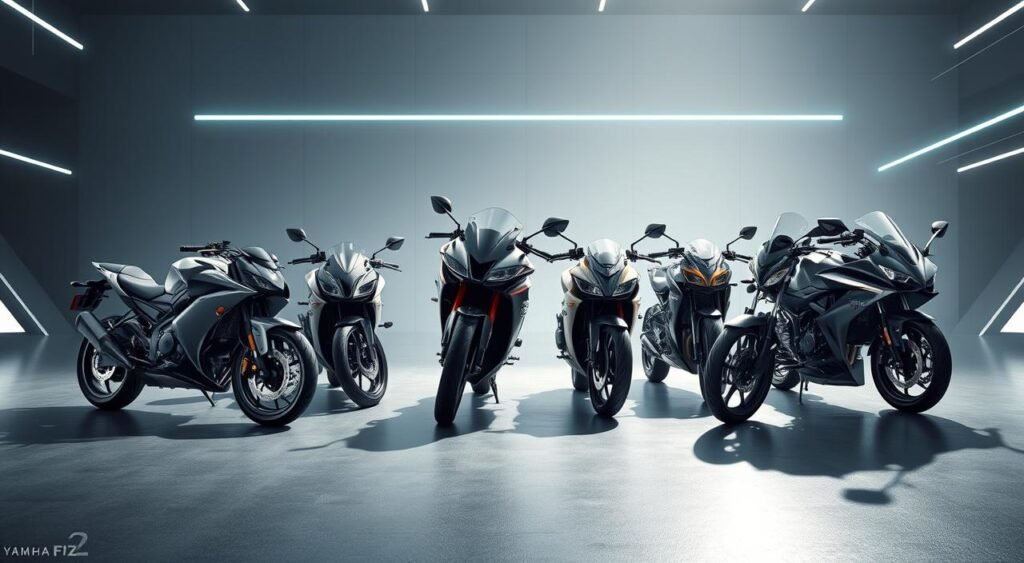
- Liquid cooling systems for better temperature management
- LED lighting for enhanced visibility
- Digital instrument clusters with ride data
- Advanced braking systems for safety
- Variable valve actuation for better performance
The 2025 FZ-S Fi shows how far Yamaha has come. It has 12.4 PS power and 13.3 Nm torque. It also gets about 60 kilometers per liter, making it very fuel-efficient.
Impact of Consumer Feedback
Rider feedback has been key in improving Yamaha FZ models. People wanted better seats, so Yamaha made them more comfortable. The FZ-S was made to look better and be more comfortable.
Younger riders asked for tech like smartphone connectivity and traction control. Yamaha listened and added these features to their bikes.
The Yamaha FZ in the American Market
The Yamaha FZ series had a big challenge when it came to the American market. In Asia, the FZ was a huge hit, but in America, riders had other ideas. Yamaha had to change its game to compete with the big names in naked bikes.
Early Reception and Sales Performance
When the FZ hit American showrooms, riders were curious. It was seen as a middle ground between beginner bikes and high-end naked bikes. The FZ-07 (MT-07) was a hit with new riders who wanted a bike that was both affordable and powerful.
The Yamaha FZ comparison with Honda’s CB series showed some interesting facts. Honda was strong in the beginner market, but Yamaha found its spot with better value and sporty looks. From 2014-2016, the FZ series grabbed 15% of the naked bike market.
Market Strategies Over Time
Yamaha’s marketing changed a lot to win over American riders. They moved from seeing the FZ as a beginner bike to a cool urban ride for more experienced riders. Their new tactics included:
- Highlighting the bike’s racing roots in ads
- Working with riding schools to show the FZ’s easy-to-learn features
- Expanding where you could find the bike, with demo rides and financing
- Building online groups to keep riders loyal
They also brought out bigger models like the FZ-09 (MT-09) for riders wanting more power but keeping the bike’s famous agility.
Engine Development: Then and Now
The Yamaha FZ bike has seen big changes in its engine over the years. It moved from simple air-cooled engines to advanced fuel-injected ones. This shows Yamaha’s dedication to new tech and meeting rider needs and emission rules in India.
Early Engine Specifications
The first Yamaha FZ had a 153cc air-cooled single-cylinder engine. It used a carburetor for fuel and made 14 PS at 7,500 RPM and 13.6 Nm torque at 6,000 RPM. Its design was simple but reliable for city rides.
These early bikes had a 2-valve SOHC setup. The carburetor was basic but worked well for city driving. Riders loved its strong mid-range and unique sound.
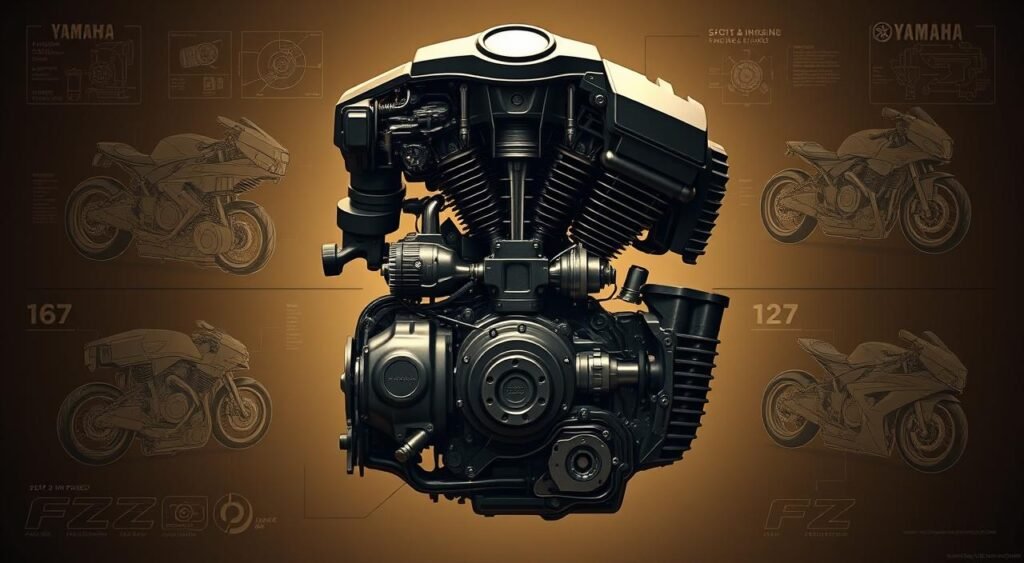
Transition to More Efficient Engines
The Yamaha FZ got a big upgrade with fuel injection. The FZ-S Fi model brought in electronic fuel injection, replacing the carburetor. This made fuel mixing better and cut down emissions a lot.
Today’s bikes have:
- Blue Core tech for better combustion
- Liquid cooling for steady performance
- Less friction parts
- Better oil flow systems
| Specification | Early FZ (2008) | Current FZ-S Fi |
|---|---|---|
| Displacement | 153cc | 149cc |
| Power Output | 14 PS @ 7,500 RPM | 12.4 PS @ 7,250 RPM |
| Torque | 13.6 Nm @ 6,000 RPM | 13.3 Nm @ 5,500 RPM |
| Fuel System | Carburetor | Fuel Injection |
| Cooling | Air-cooled | Air-cooled |
| Mileage | 45-50 kmpl | 58-60 kmpl |
The newest engines focus on fuel efficiency and low-end torque. This meets the needs of riding in Indian cities, where quick throttle response is key, not just high speed.
Design Innovations: Classic to Contemporary
The Yamaha FZ models have changed a lot over the years. They went from simple bikes to modern urban rides. The early bikes were all about being useful, not looking good. Now, they have cool designs with sharp lines and bright lights that attract young riders in India.
Aesthetic Changes in the FZ Series
The first FZ in 2008 had simple round headlights and few body parts. By 2014, Yamaha made the bikes look more aggressive with new fuel tanks and seats. The 2019 model had LED lights and strong bodywork. The latest changes include:
- Sharp, aerodynamic body panels replacing curved surfaces
- Digital instrument clusters instead of analog meters
- Metallic paint schemes with special edition graphics
- Integrated grab rails and refined tail sections
Ergonomics and Rider Comfort Improvements
Rider comfort has gotten much better over time. Yamaha worked on the handlebars, footpegs, and seats to fit different riders. The seat height went down from 795mm to 790mm, making it easier for more people to ride.
| Feature | Early FZ (2008-2013) | Current FZ (2019-2025) |
|---|---|---|
| Seat Type | Single-piece unit | Split seat design |
| Handlebar Width | 740mm | 760mm |
| Pillion Comfort | Basic grab rail | Integrated grab handles |
| Footpeg Position | Rear-set sporty | Neutral comfortable |
These changes made the Yamaha FZ better for city rides and occasional highway trips. The 2025 FZ-S Fi shows this with optimized ergonomics for daily city rides and occasional highway trips.
Safety Features: Historical vs Modern
The Yamaha FZ series has seen big changes in safety over the years. Early models had basic safety features that were common back then. Now, the FZ motorcycles have advanced safety tech, thanks to years of improvement and feedback from riders.
Safety Standards in Initial Models
Older FZ models had basic safety parts for reliability. The cheaper ones had drum brakes, while the fancier ones had single disc brakes. The main goal was to make them strong and dependable.
Early safety features included:
- Basic drum brake systems on affordable models
- Single disc brakes for higher-end variants
- Standard halogen headlights for night visibility
- Reinforced frame construction for rider protection
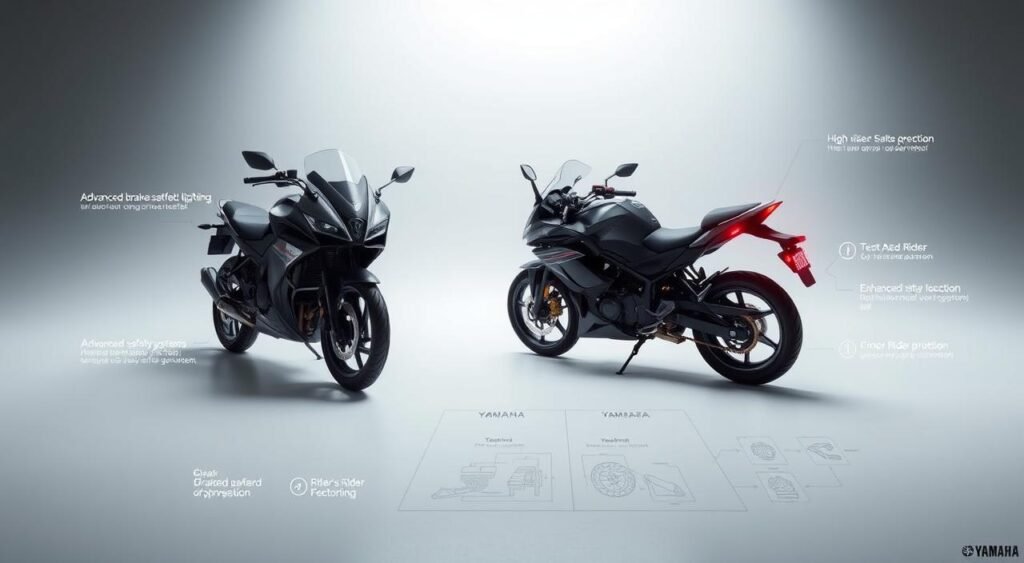
Introduction of New Technologies
Modern Yamaha FZ upgrades have brought big changes in safety. Comparing old and new FZ models shows huge leaps in braking and safety.
Today’s safety upgrades include:
- Single-channel ABS on select models for better braking
- Larger disc rotors with improved caliper designs
- LED lighting systems replacing old halogen bulbs
- Side-stand engine cut-off switches to prevent accidental starts
- Advanced tire specs for better road grip
These new features show Yamaha’s dedication to keeping riders safe while keeping the FZ’s great performance.
Performance Metrics: Past Performance vs Current
The Yamaha FZ has seen big improvements in performance over the years. Its early models set high standards for naked street bikes in India. Now, the bike offers more power and better fuel efficiency.
The switch from carbureted to fuel-injected engines was a key moment. It marked a big step forward in the bike’s performance.
Acceleration and Riding Experience Over Time
Older FZ models could go from 0 to 60 kmph in 5.5 seconds. They could reach speeds of 115 kmph. Riders felt a direct connection to the engine.
Today’s FZ bikes are just as fast but smoother. They have better throttle response and less vibration at high speeds. This makes for a more enjoyable ride.
Modern FZ bikes have better gear ratios and clutch mechanisms. This makes city rides easier and less tiring. The 2025 FZ-S Fi handles well in different weather, unlike older models.
Fuel Efficiency Improvements
Fuel efficiency has seen a big leap in the Yamaha FZ’s history. The switch to fuel injection technology made a big difference:
| Model Year | Engine Type | Mileage (kmpl) | Improvement |
|---|---|---|---|
| 2008-2014 | Carbureted | 45-48 | Baseline |
| 2014-2019 | FI Version 2.0 | 50-54 | 12% increase |
| 2019-2025 | FI Version 3.0 | 58-60 | 25% increase |
Aerodynamic changes and better engine mapping have helped improve efficiency. The latest BS6-compliant engines also meet strict emission standards. They offer better mileage than before.
Competitor Landscape: Then and Now
The Yamaha FZ bike’s world has changed a lot. It went from a simple commuter bike to a high-tech choice. Now, it’s all about performance, tech, and value.
Early Rivals in the Motorcycle Market
The FZ first hit Indian roads, facing Honda’s CB Unicorn and Bajaj Pulsar. These bikes were known for being fuel-efficient and reliable. Hero Honda also had models in the same size, but they were more for daily use.
The Yamaha FZ comparison showed it had better looks and handling. While others focused on being practical, the FZ stood out with its sporty design. This made it a favorite among those who wanted more than just a ride.
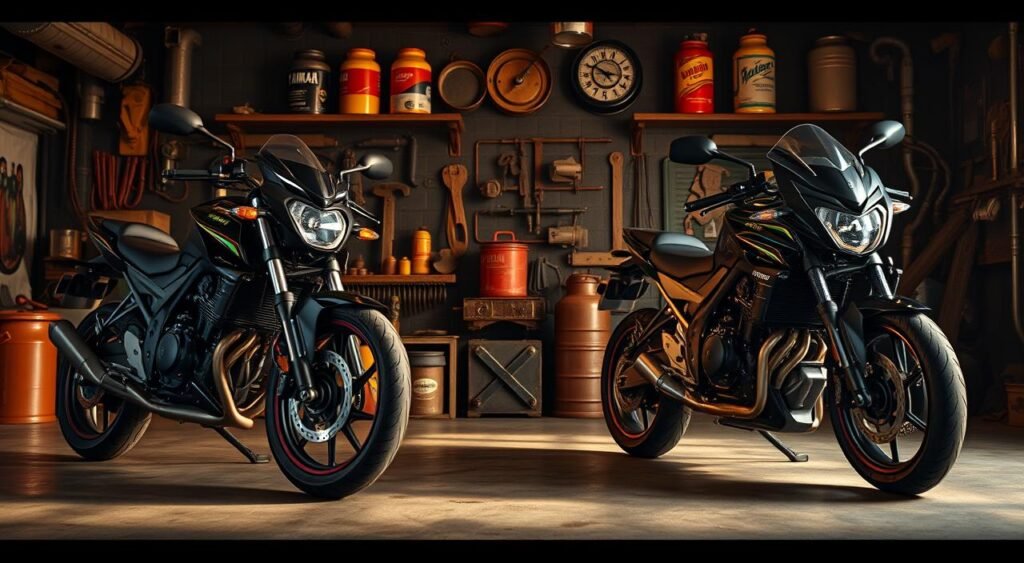
Recent Competitors and Market Position
Now, the Yamaha FZ faces even tougher competition. New rivals include:
- KTM’s affordable and powerful bikes
- TVS Apache series with cool features
- Hero Xtreme 125R for new buyers
- Honda’s updated CB lineup
The FZ stays strong thanks to updates and loyal fans. Its racing background appeals to those looking at top sports bikes in India. Its wide dealer network and reliability keep attracting customers, even with new options.
Community Culture Surrounding Yamaha FZ
The Yamaha FZ has sparked more than just rides—it has created a vibrant community. This community spans across India and beyond. Riders drawn to the distinctive style and performance of Yamaha FZ models have built lasting connections.
Formation of Riding Clubs and Cult Followings
Riding clubs dedicated to the Yamaha FZ began appearing in cities like Mumbai, Delhi, and Bangalore as early as 2009. These groups organize weekend breakfast rides, technical workshops, and modification meets. Owners showcase their customized bikes at these events.
The FZ Riders Club India, one of the largest groups, boasts over 15,000 active members. They participate in annual rides and charity events.
Local chapters maintain WhatsApp groups and organize monthly meetups at popular riding destinations. Members share maintenance tips and recommend trusted mechanics. They help newcomers navigate the world of Yamaha FZ ownership.
This grassroots movement has transformed individual riders into a tight-knit community.
The Role of Social Media in FZ Enthuasiasm
Instagram pages like @fz_nation and @yamaha_fz_official showcase stunning photography of modified Yamaha FZ models. They attract thousands of followers. YouTube channels run by enthusiasts provide detailed reviews and modification guides.
Facebook groups serve as marketplaces where members trade aftermarket parts and share technical solutions. Digital platforms have made expertise accessible to all FZ owners. A rider in Chennai can instantly get troubleshooting help from someone in Pune.
This interconnected network strengthens the bond among Yamaha FZ enthusiasts. It influences future model development through collective feedback.
Yamaha’s Commitment to Sustainability
Yamaha knows it has a big role in protecting the environment. It has made big changes in how it makes motorcycles. The Yamaha FZ evolution is a big step towards being kinder to the planet without losing performance.
The company works hard to make its production green. It looks at everything from how it makes parts to how it meets emission standards. Yamaha keeps finding new ways to be eco-friendly in its factories.
Environmentally Friendly Practices Over the Years
The Yamaha FZ upgrades have always aimed to cut down on pollution. At first, they used carburetors, but switching to fuel injection was a big win for the environment. This change cut hydrocarbon emissions by up to 40% and made the bikes more fuel-efficient.

- Installation of solar panels at production facilities
- Water recycling systems saving millions of gallons annually
- Reduced packaging materials by 25% in five years
- Catalytic converter adoption across all FZ models
Future Initiatives for Eco-Friendly Production
Yamaha is setting big goals for the future of the Yamaha FZ evolution. It wants to be carbon neutral by 2050. The company is working on making its production better and its supply chain greener.
Alternative fuel compatibility is also a focus. Yamaha is testing bikes that run on ethanol blends and electric powertrains. This is all part of its plan to make motorcycles even more eco-friendly.
| Sustainability Initiative | Current Status | 2030 Target |
|---|---|---|
| Carbon Emissions | 30% reduction | 60% reduction |
| Recyclable Materials | 75% of components | 95% of components |
| Renewable Energy Use | 40% of facilities | 80% of facilities |
Customer Support and Service Evolution
The way Yamaha FZ customer support has changed shows a big shift in how bikes are sold and serviced. It moved from simple dealer talks to advanced online services. This change has greatly improved how customers are treated.
Early Customer Support Practices
In the early days of the Yamaha FZ, support was mainly through dealerships. Shops had basic tools and not many spare parts. Mechanics used paper records and manual systems for warranties.
Customers faced long waits for parts and uneven service quality. This was true across different places.
Modern Advancements in Customer Care
Now, the support for Yamaha FZ has seen big changes. The digital world has changed how riders deal with service centers. Yamaha Blue Square outlets offer the same quality everywhere.
Mobile apps let riders book services and track their bikes easily. This makes things faster and more convenient.
| Service Feature | Early 2000s | Current (2024) |
|---|---|---|
| Booking Method | Phone/Walk-in | Mobile App/Online Portal |
| Service Records | Paper Documents | Digital Database |
| Parts Availability | 2-4 Weeks Wait | 24-48 Hours |
| Technician Training | Annual Workshops | Continuous Online Modules |
| Customer Feedback | Suggestion Box | Real-time Digital Surveys |
Today, advanced tools help fix bikes quickly. Parts get to customers fast thanks to a central system. Predictive inventory management makes sure parts are always ready.
Feedback has changed from simple boxes to online surveys. This lets Yamaha keep improving its service.
The Future of the Yamaha FZ Series
The Yamaha FZ series is set to welcome new tech while keeping its unique feel. Riders will soon see big changes in how they connect with their bikes. Smartphones and advanced screens will change the game, giving riders real-time info on performance and more.
Expected Trends in Design and Technology
Expect the Yamaha FZ to get a sleeker look and better aerodynamics. It will use top-notch materials like carbon fiber and alloys to be lighter and stronger. Features like traction control and different riding modes will become common. This shows how the Yamaha FZ is moving towards smarter, safer bikes that adjust to any ride.
Predictions for Market Position in the Coming Years
The Yamaha FZ will stay ahead by mixing low prices with high-tech features. It might even add electric and hybrid models as India seeks greener transport. Its trustworthiness and value will keep it strong against Honda CB Hornet and Bajaj Pulsar. Experts say the Yamaha FZ will grow its spot in the entry-level market with tech usually found in pricier bikes.
FAQ
What are the main differences between early Yamaha FZ models and the 2025 FZ-S Fi?
Early Yamaha FZ models had air-cooled engines and carburetors. They produced 13-14 PS power and had basic features. The 2025 FZ-S Fi has liquid cooling, fuel injection, and LED lights. It also has digital displays and produces 12.4 PS with 13.3 Nm torque. It gets about 60 kmpl, better than the early models’ 45-50 kmpl.
How has the Yamaha FZ evolution impacted its performance metrics?
The Yamaha FZ evolution has kept the 0-60 kmph time at 5-6 seconds. It has improved mid-range performance and vibration isolation. Modern models offer smoother power delivery and better thermal management. They also provide enhanced riding comfort compared to the early models.
What major Yamaha FZ upgrades occurred from 2006 onwards?
From 2006, the Yamaha FZ got fuel injection, liquid cooling, and LED lights. It also got digital displays and better chassis designs. Recent models have variable valve actuation, traction control, smartphone connectivity, and single-channel ABS.
How does the current Yamaha FZ comparison fare against competitors?
The current Yamaha FZ compares well against rivals like Hero Xtreme 125R and TVS Raider. It’s known for reliability, a wide dealer network, and updates. The 2025 FZ-S Fi offers advanced features and about 60 kmpl fuel efficiency at a competitive price.
What are the key Yamaha FZ changes in design philosophy?
The Yamaha FZ design has changed from utilitarian to sophisticated urban motorcycles. It now has sharp bodywork, muscular fuel tanks, LED lights, and aerodynamic enhancements. It keeps its aggressive styling heritage.
Which Yamaha FZ models have been most significant in the series history?
Key Yamaha FZ models include the original air-cooled variants and the 2006 fuel-injected versions. The FZ-S variant added comfort features. The 2025 FZ-S Fi is the latest evolution with 12.4 PS power and modern connectivity.
How has Yamaha FZ history influenced motorcycle culture?
Yamaha FZ history has built strong owner communities through clubs and online forums. The model’s modification culture has grown with aftermarket parts. Annual meets and digital platforms strengthen bonds, influencing future models and creating cultural impact.
What can we expect from the future Yamaha FZ bike development?
Future Yamaha FZ bikes may have advanced rider assistance systems and connectivity features. They might include electric or hybrid variants and better fuel efficiency. Expect traction control, riding modes, digital displays, and IoT integration while keeping performance and value.
